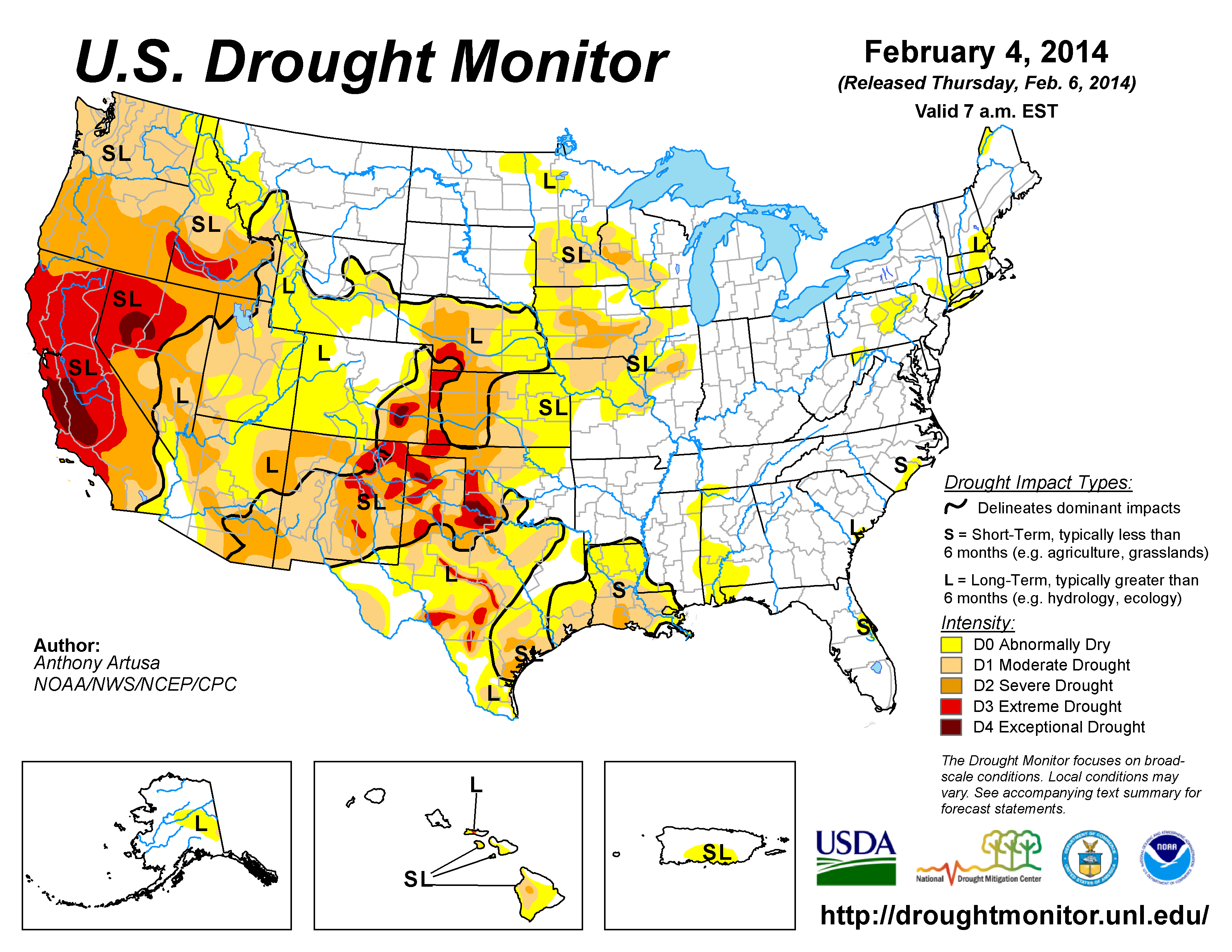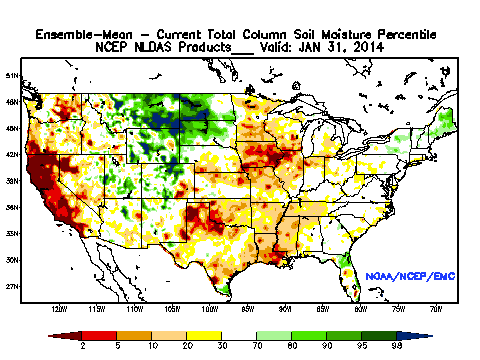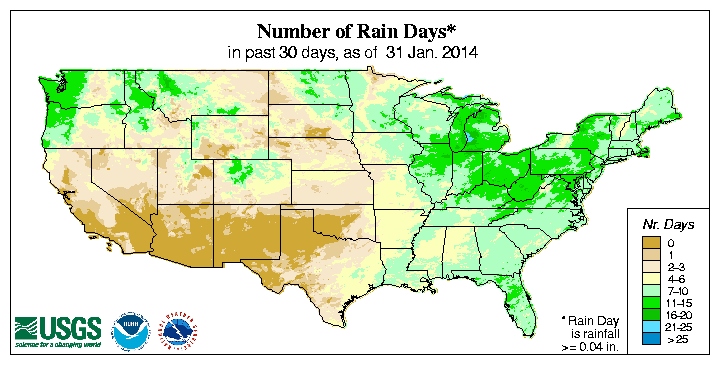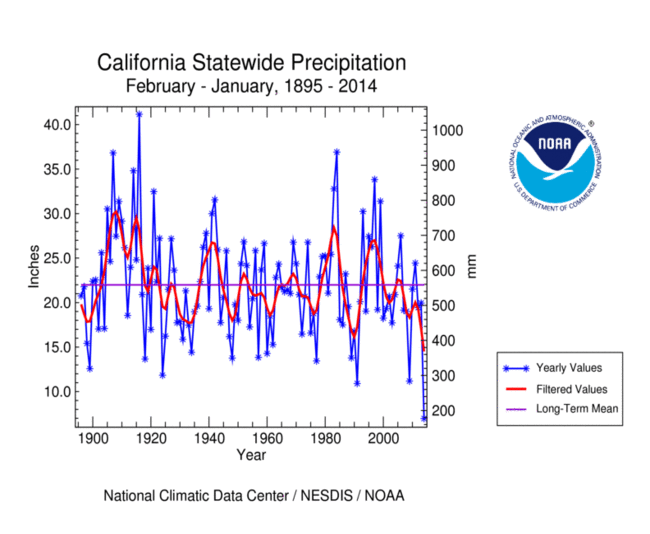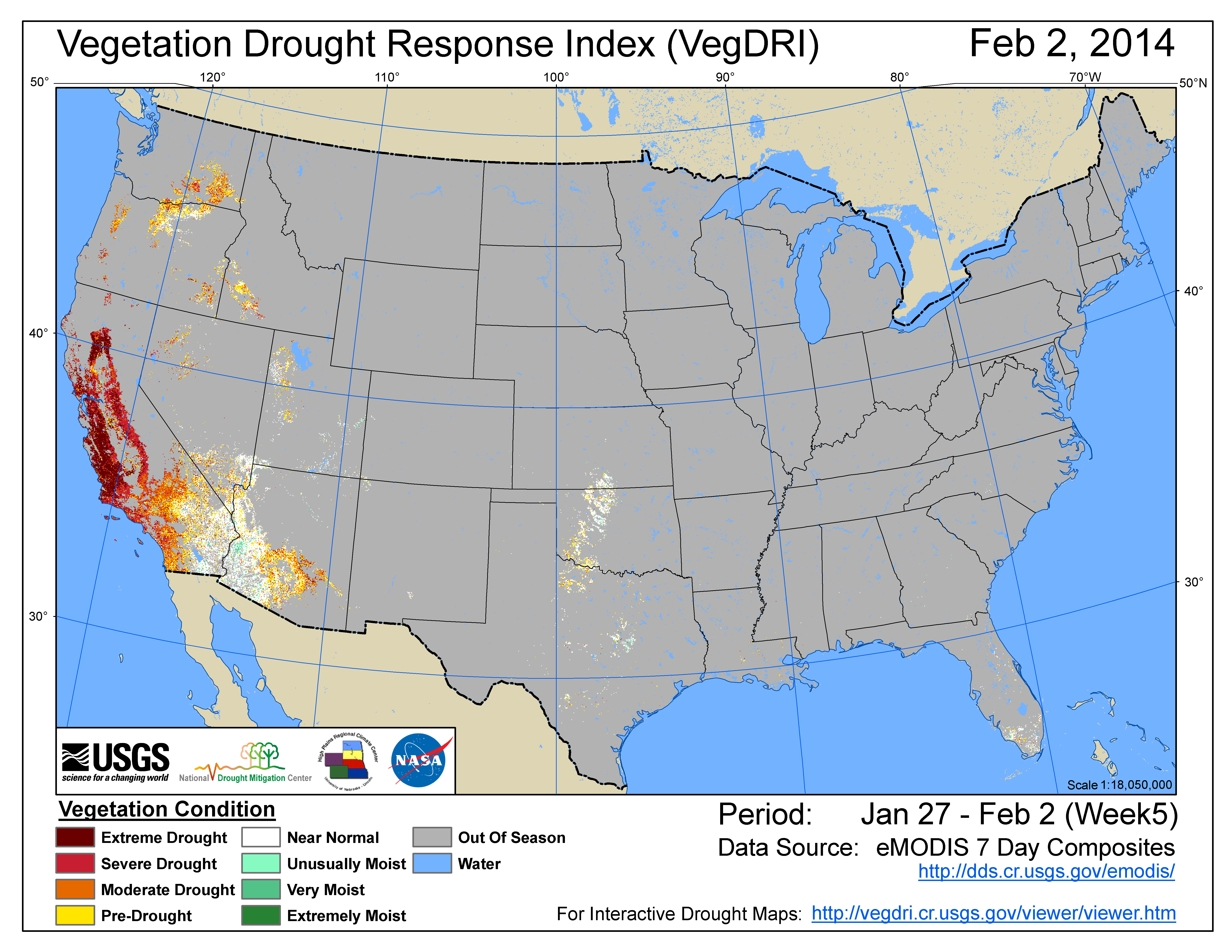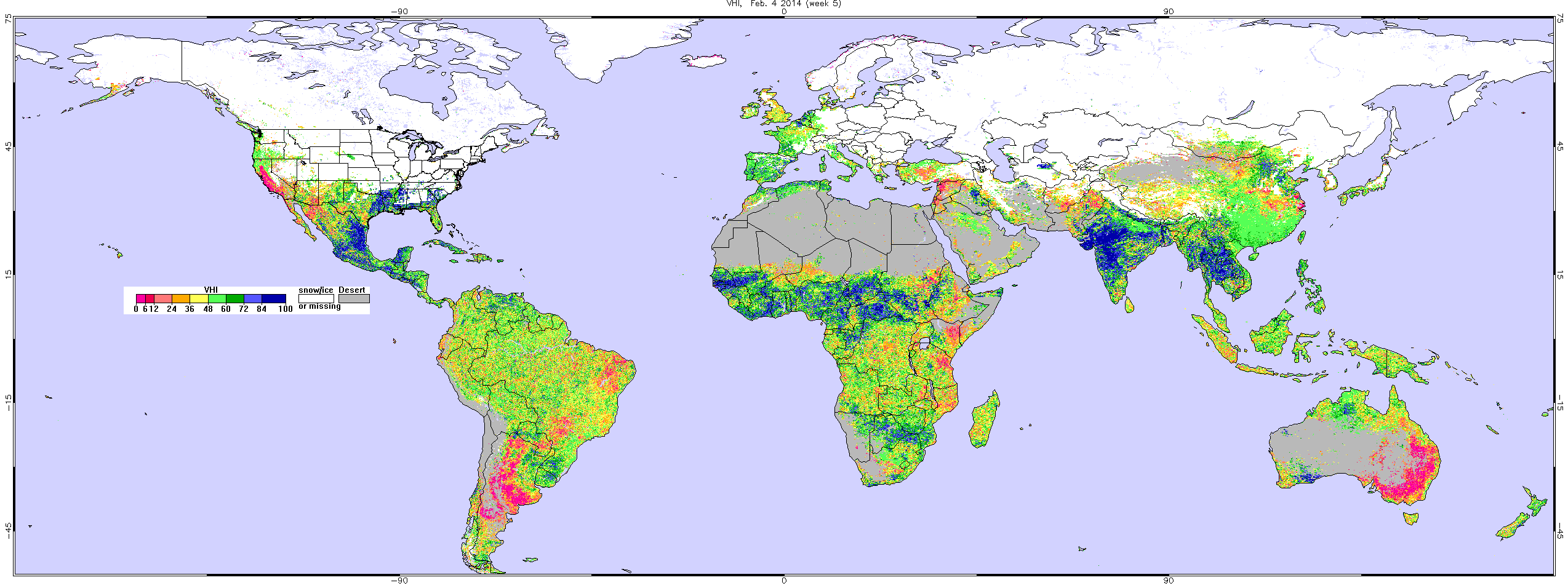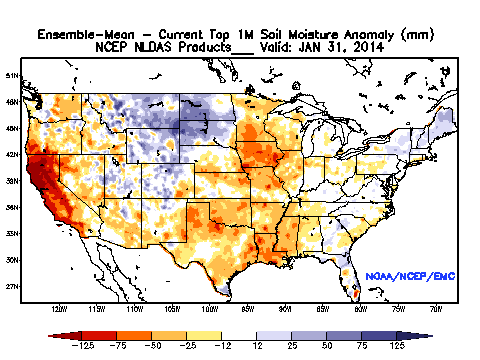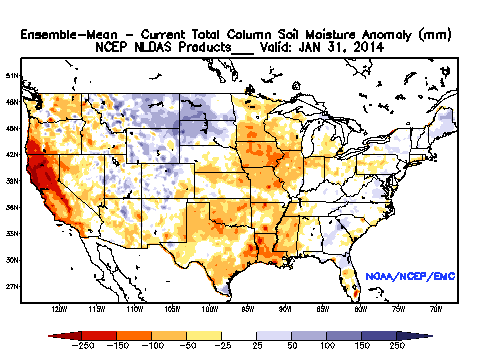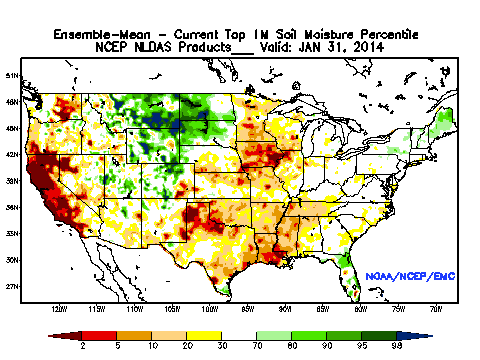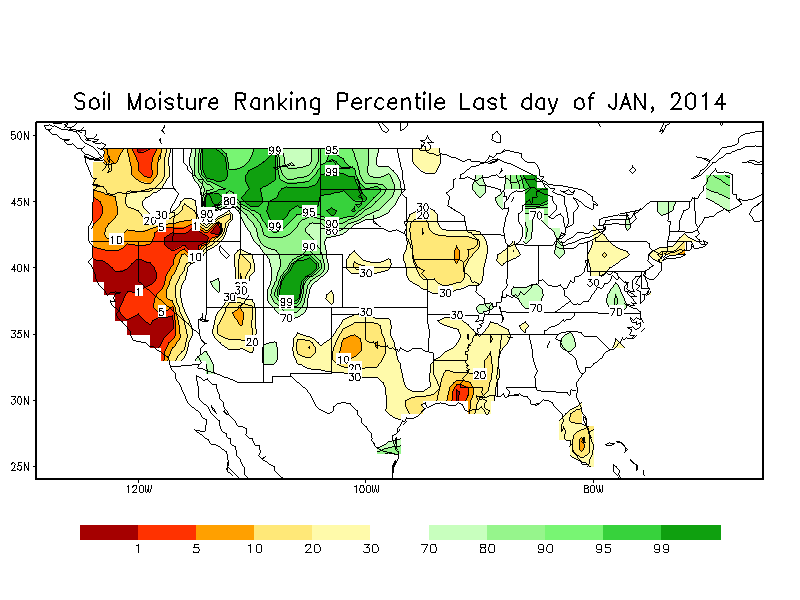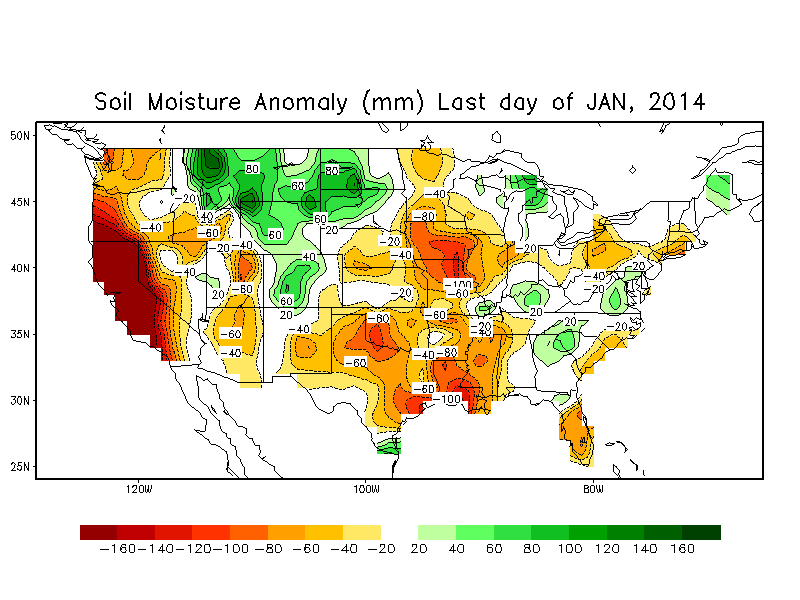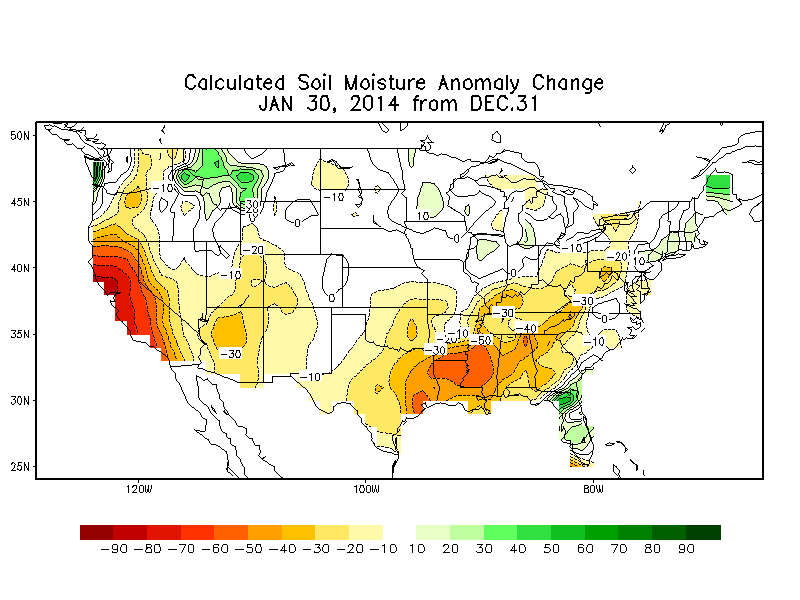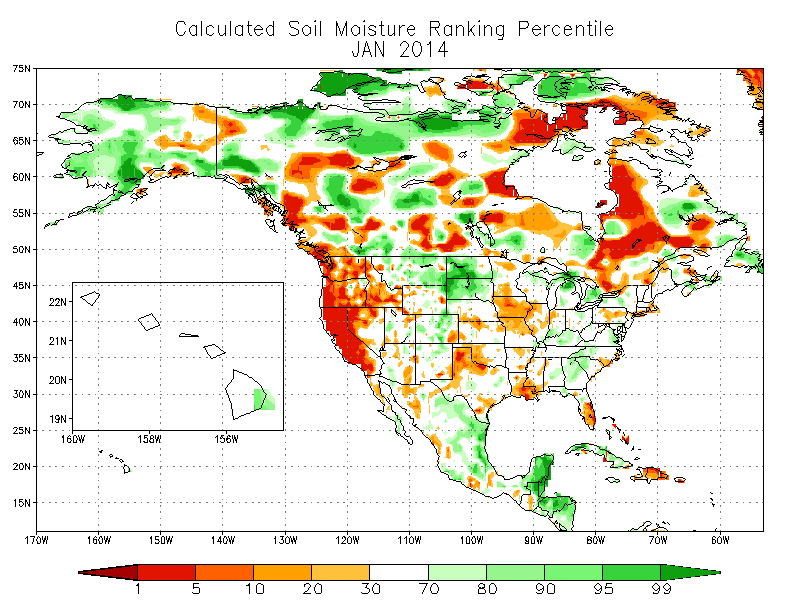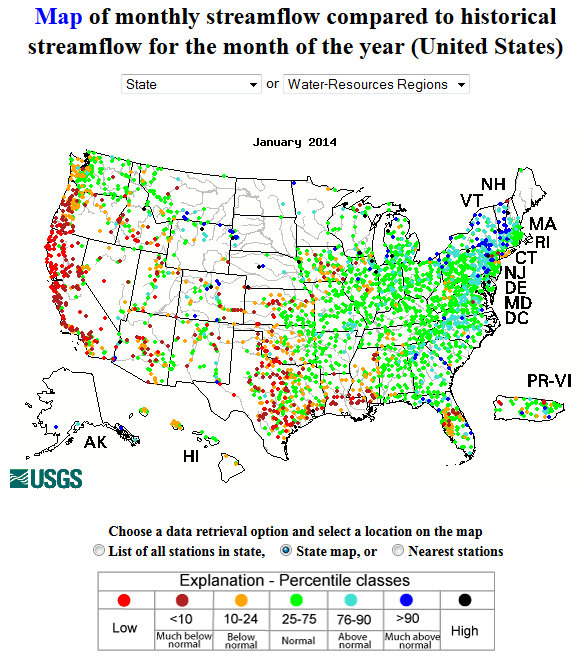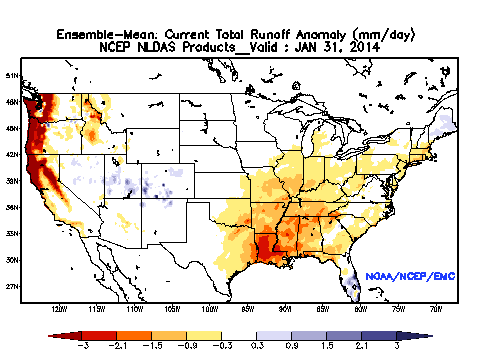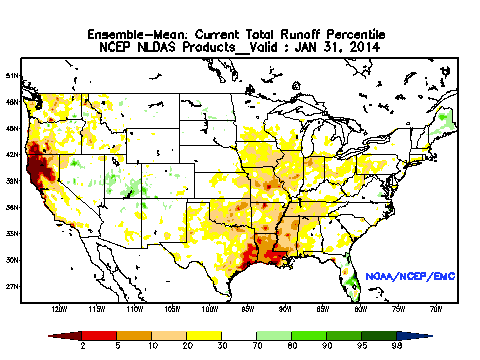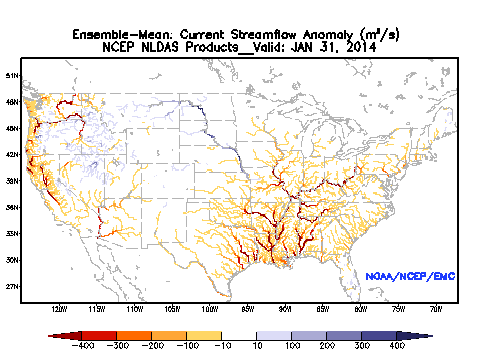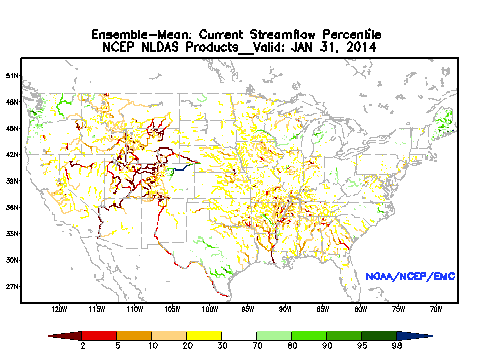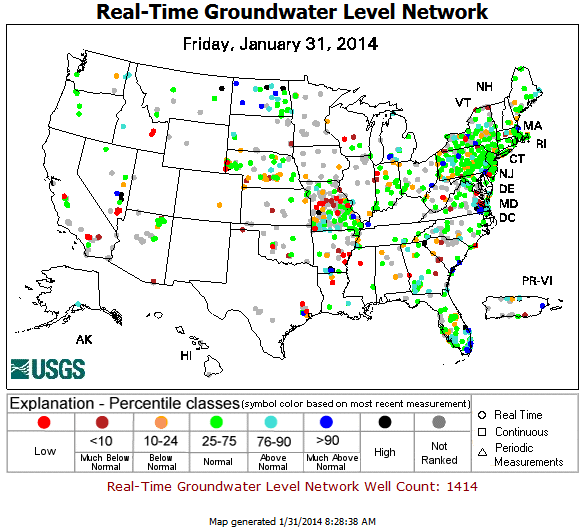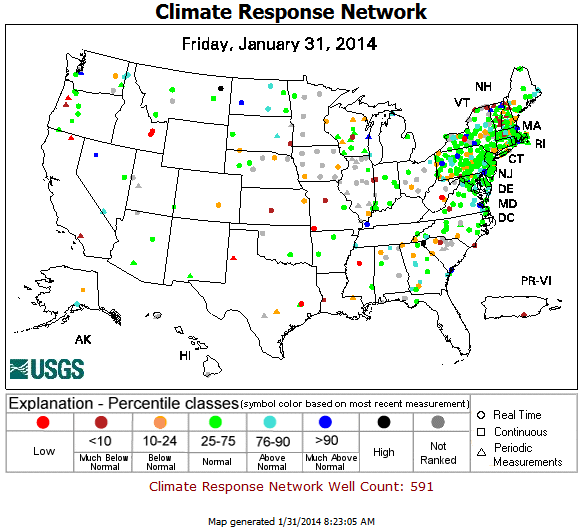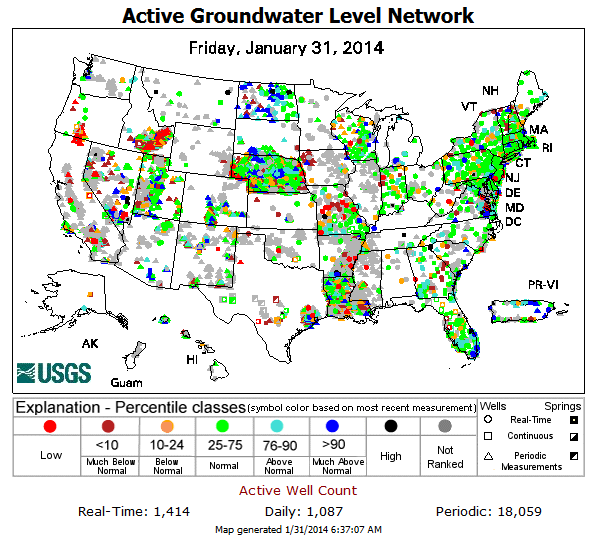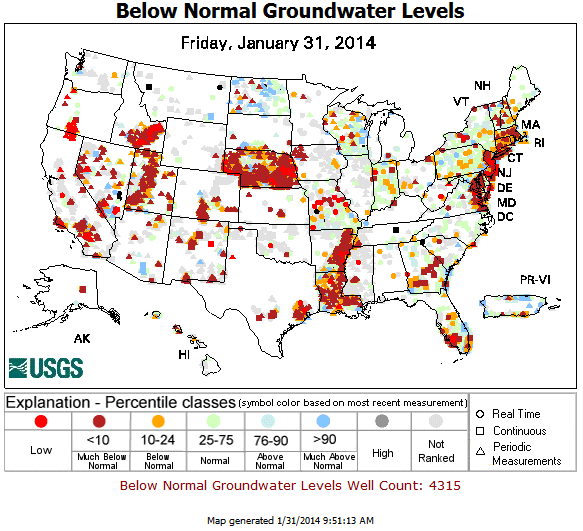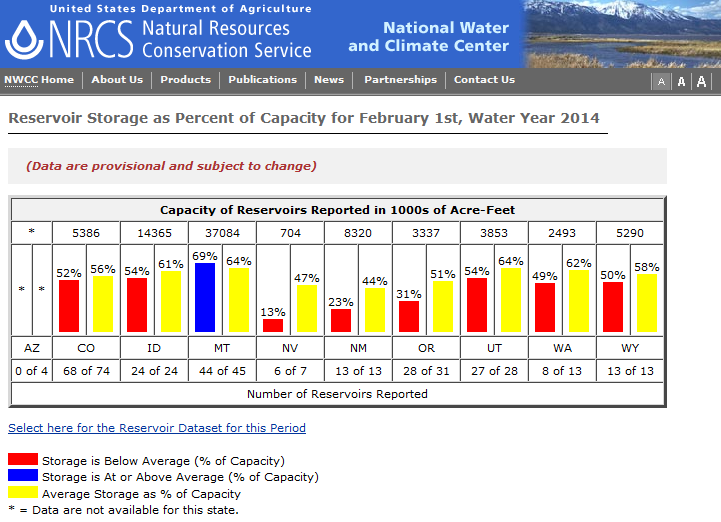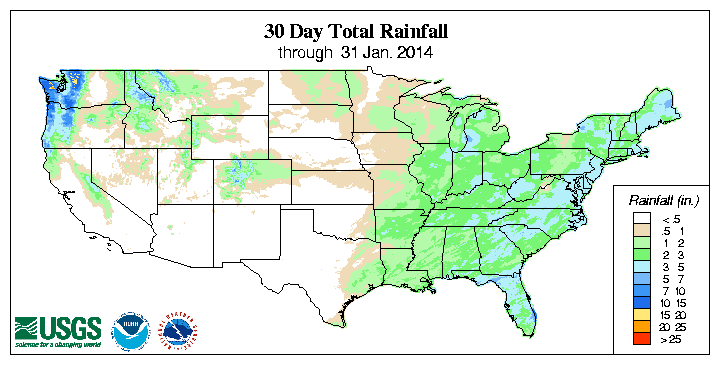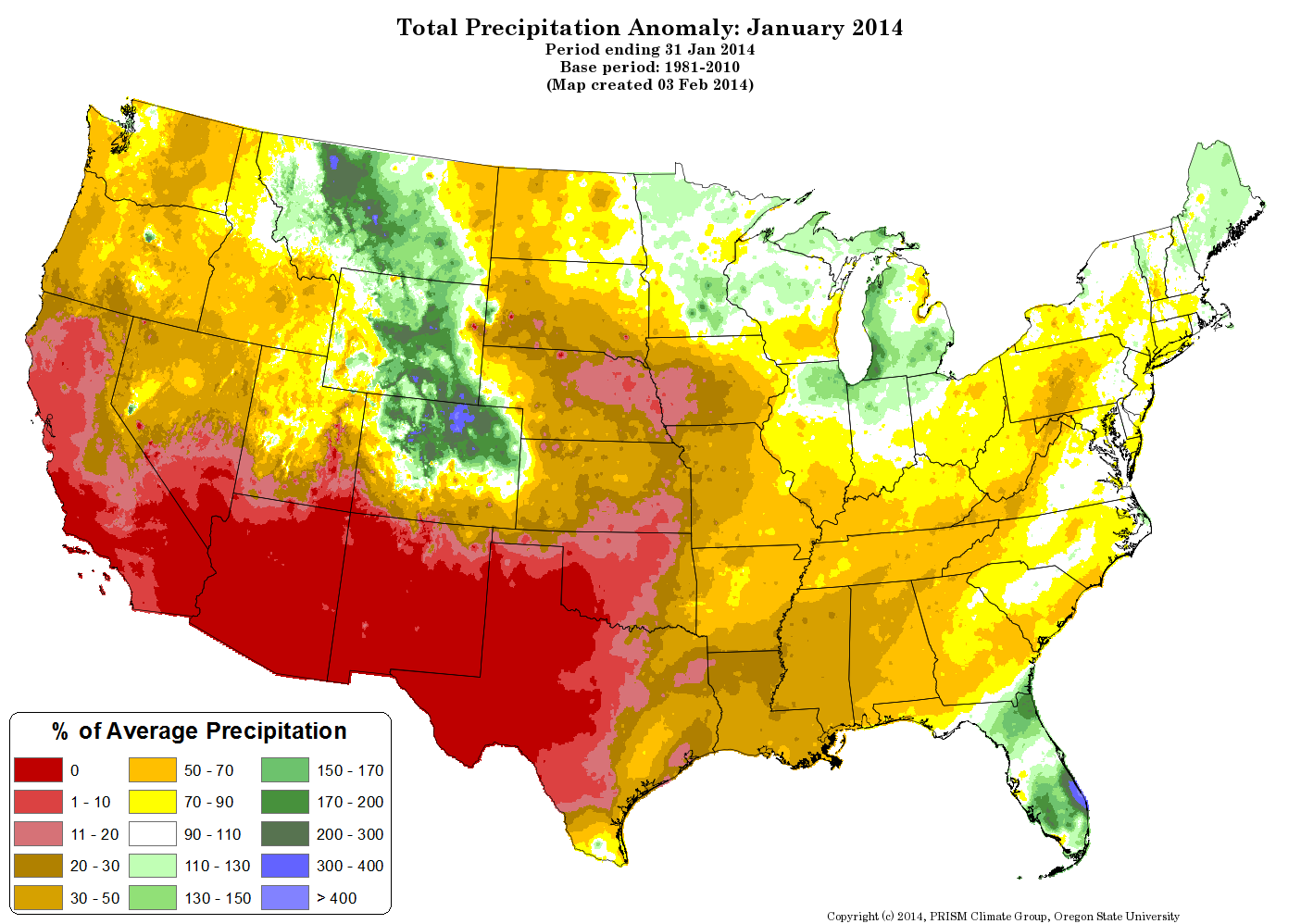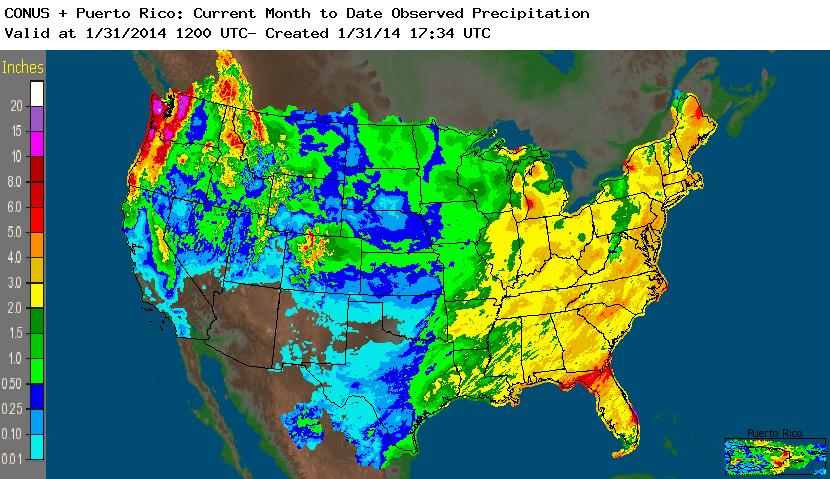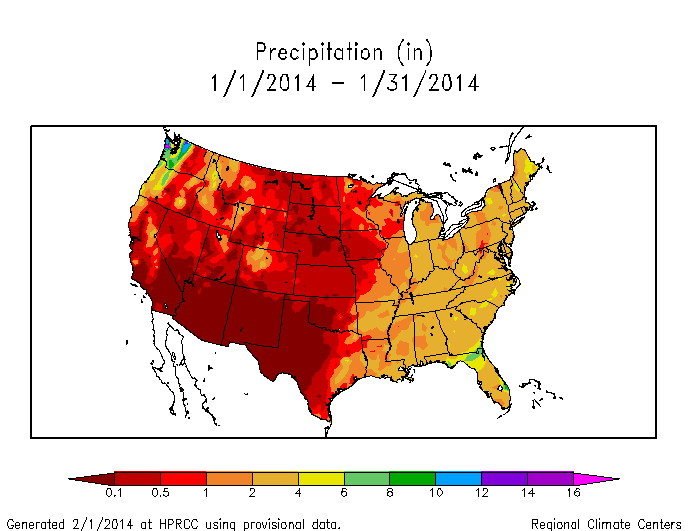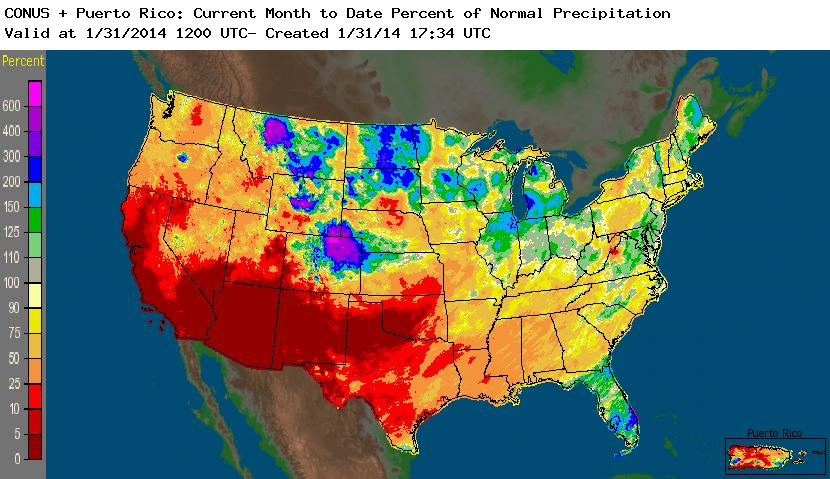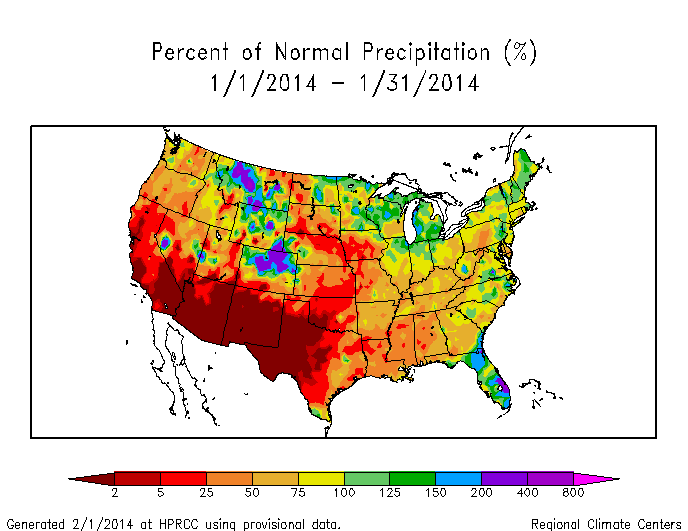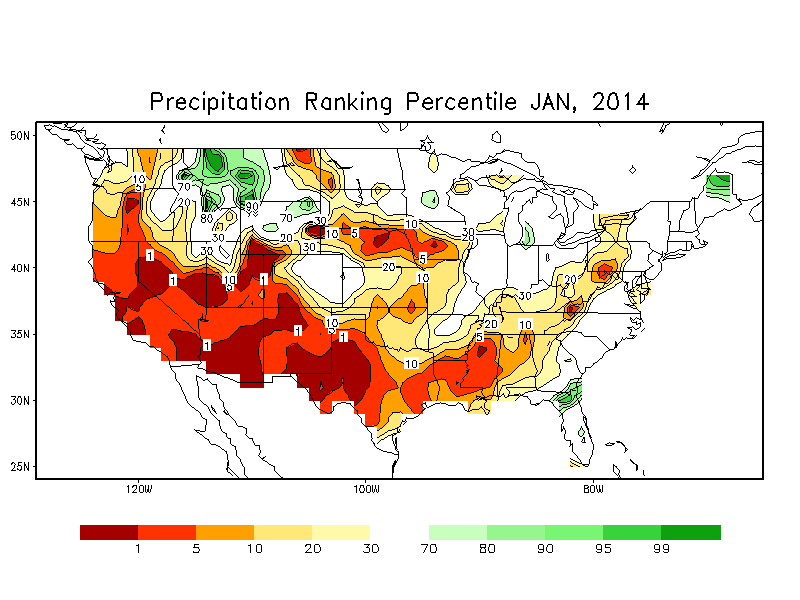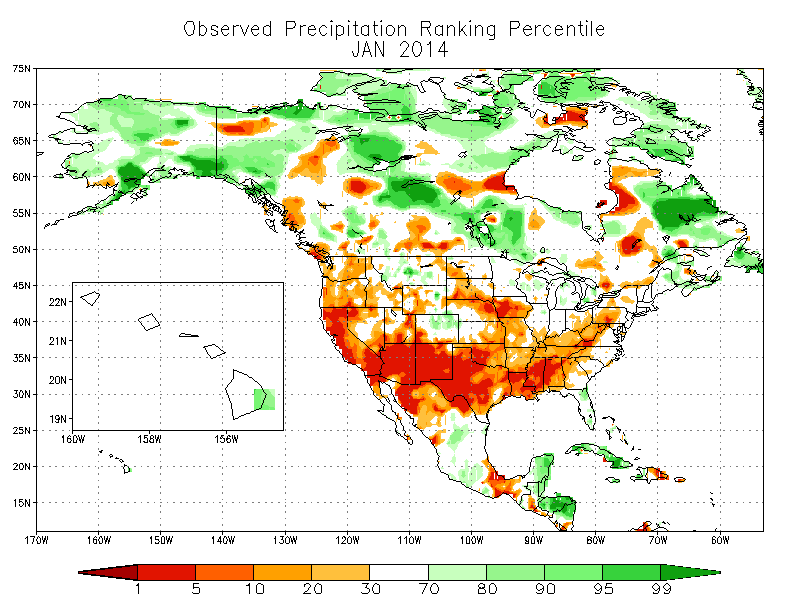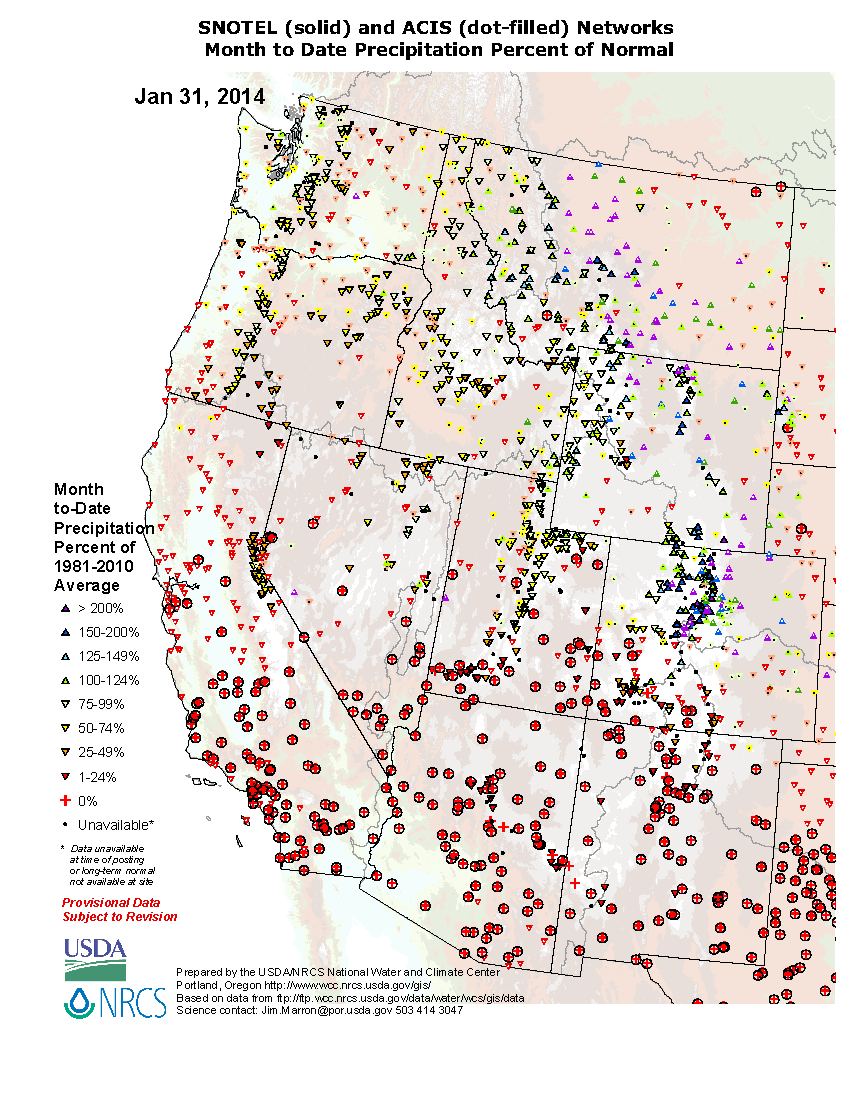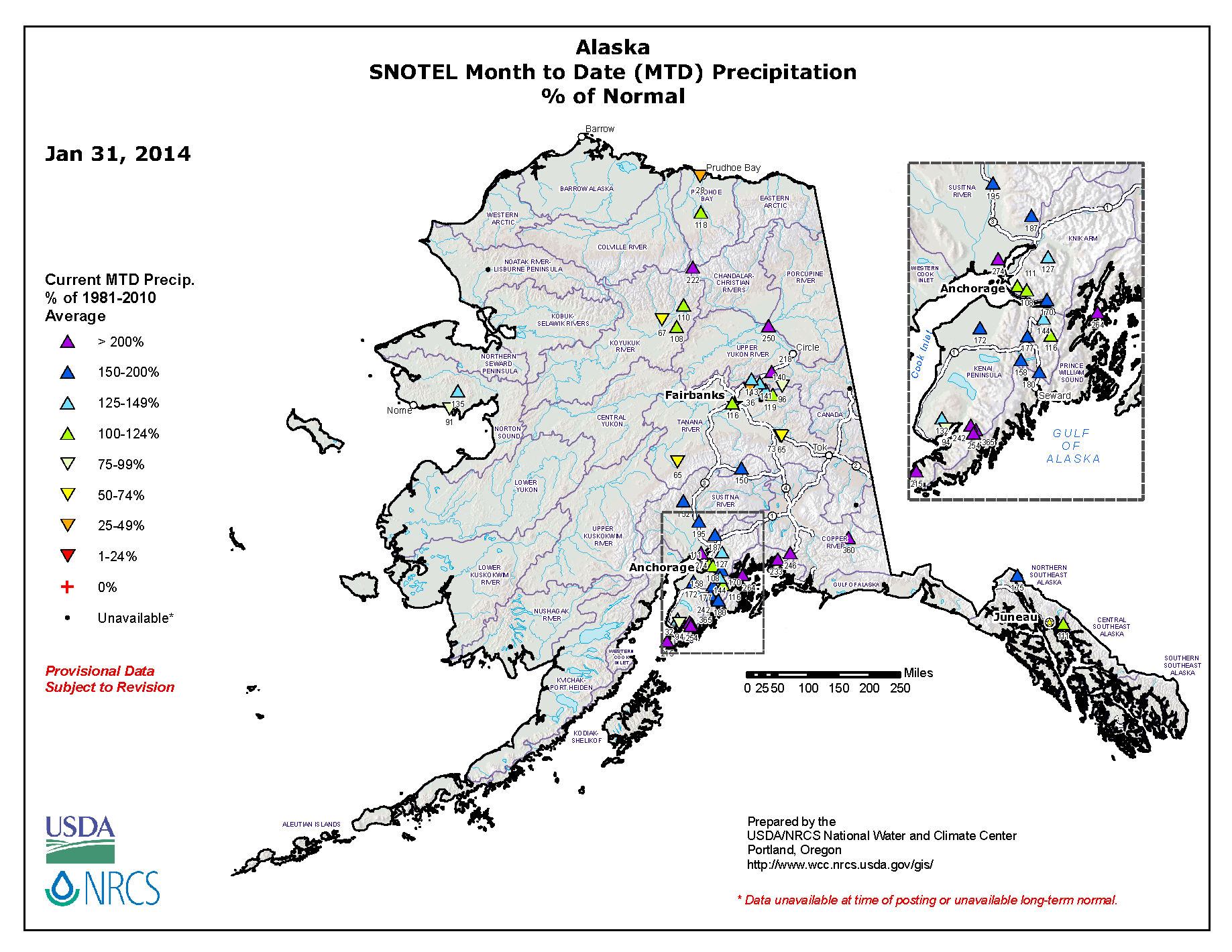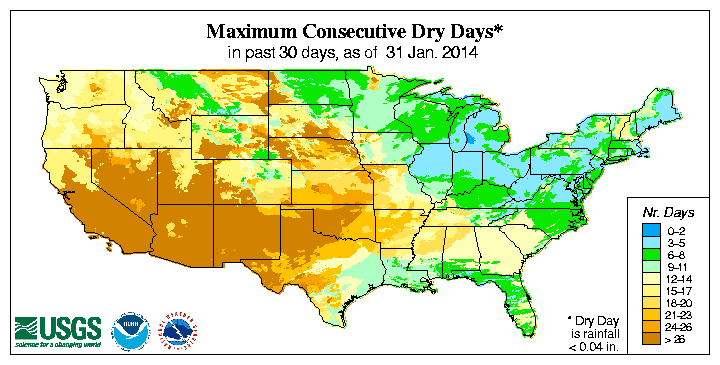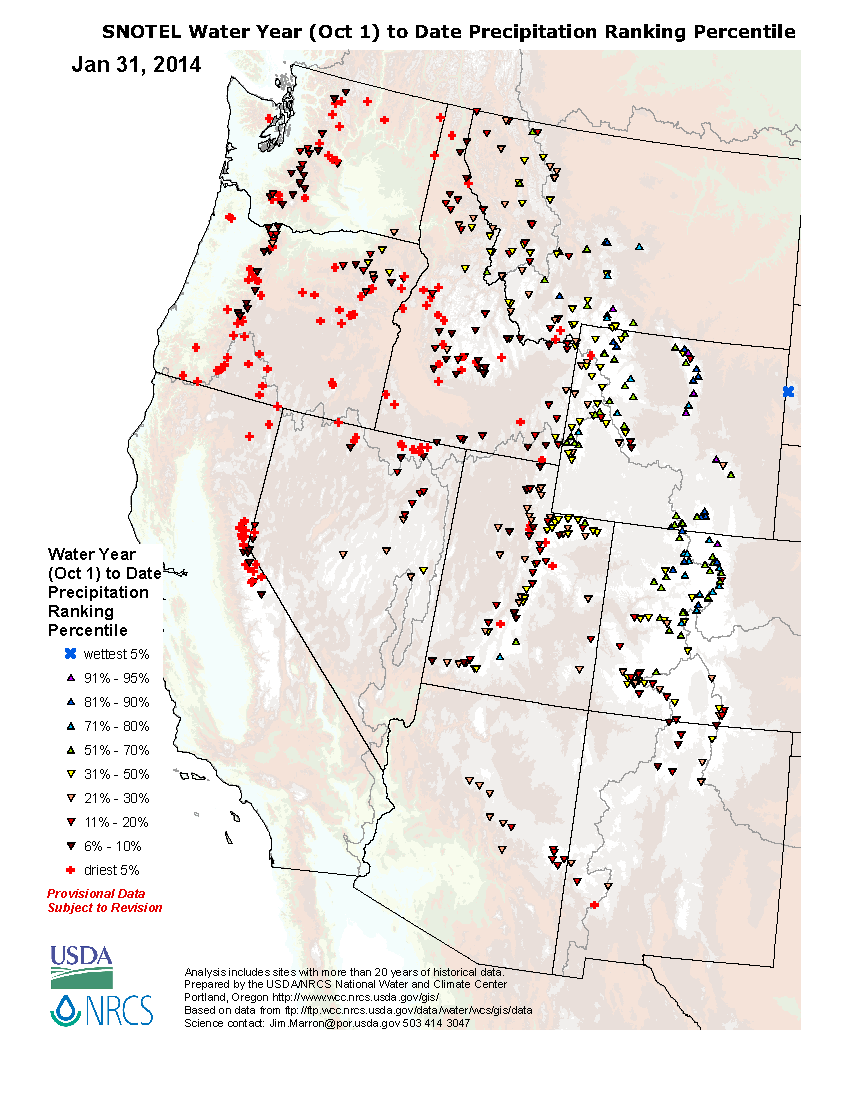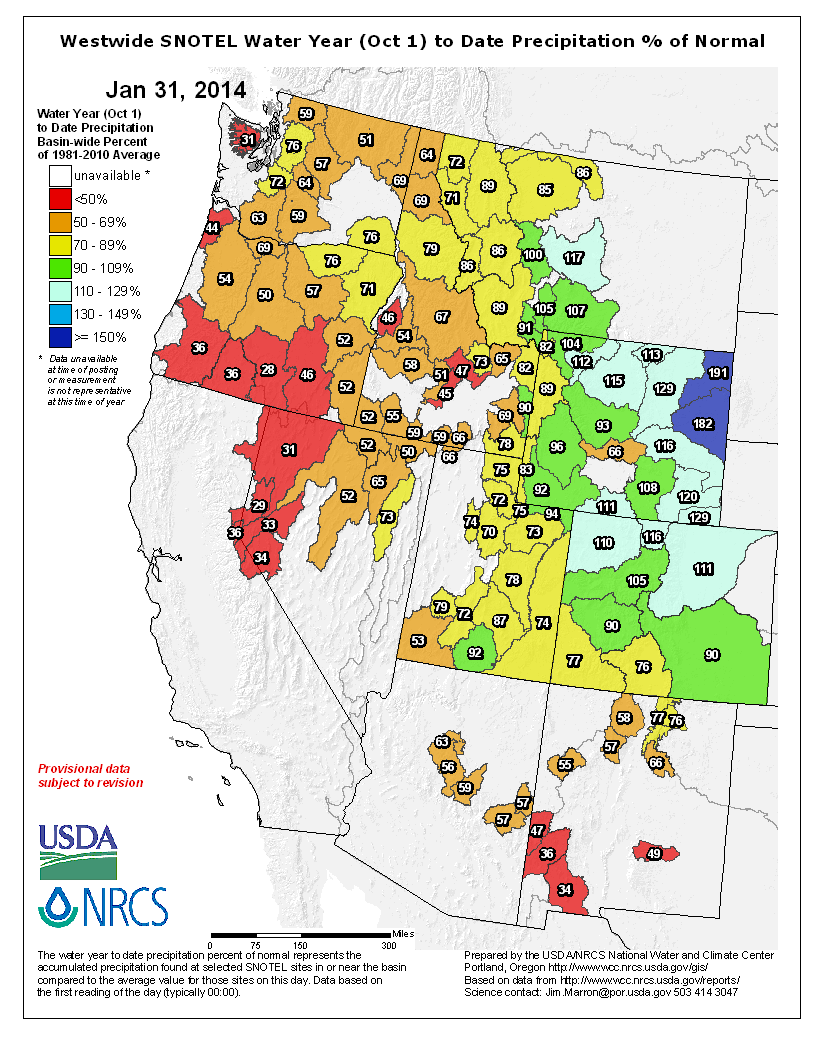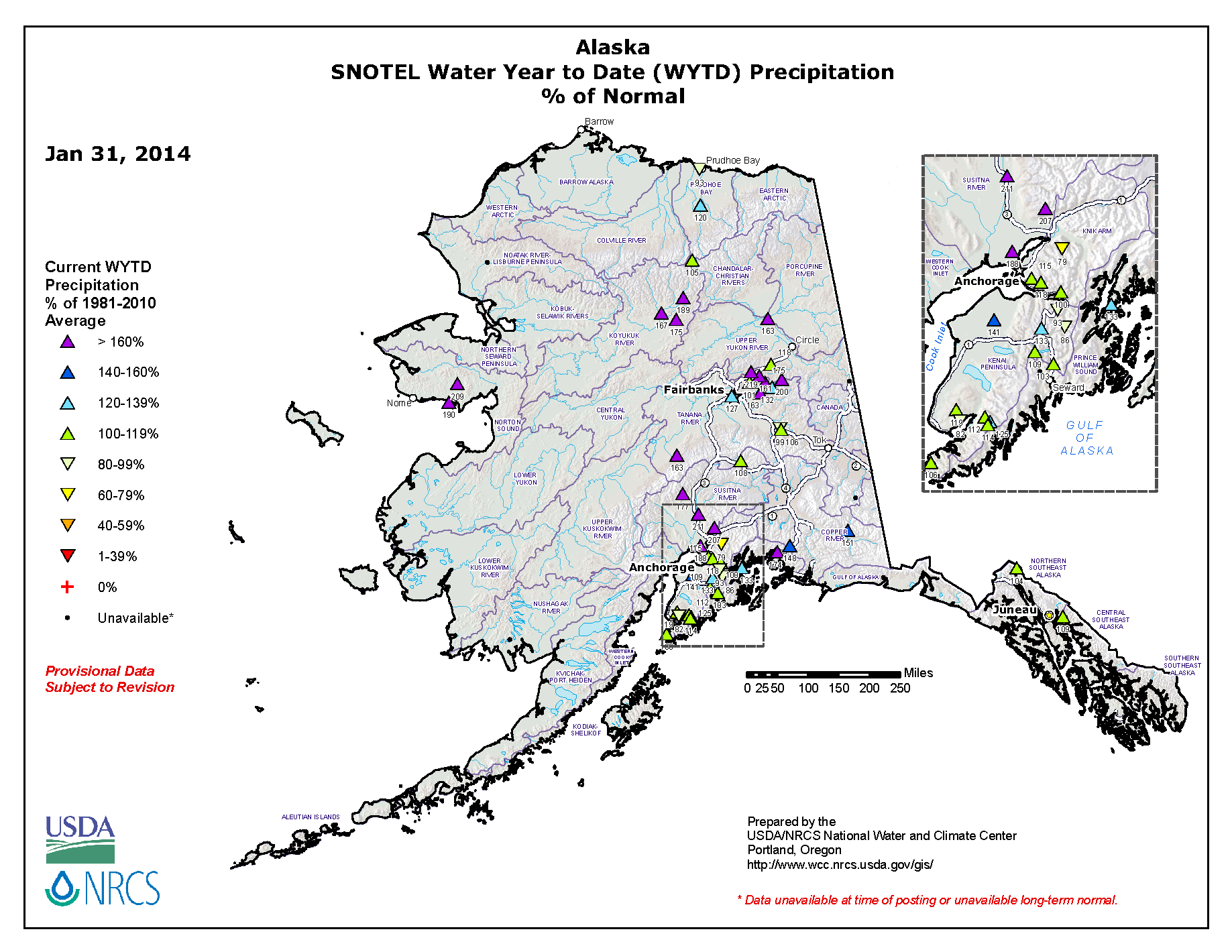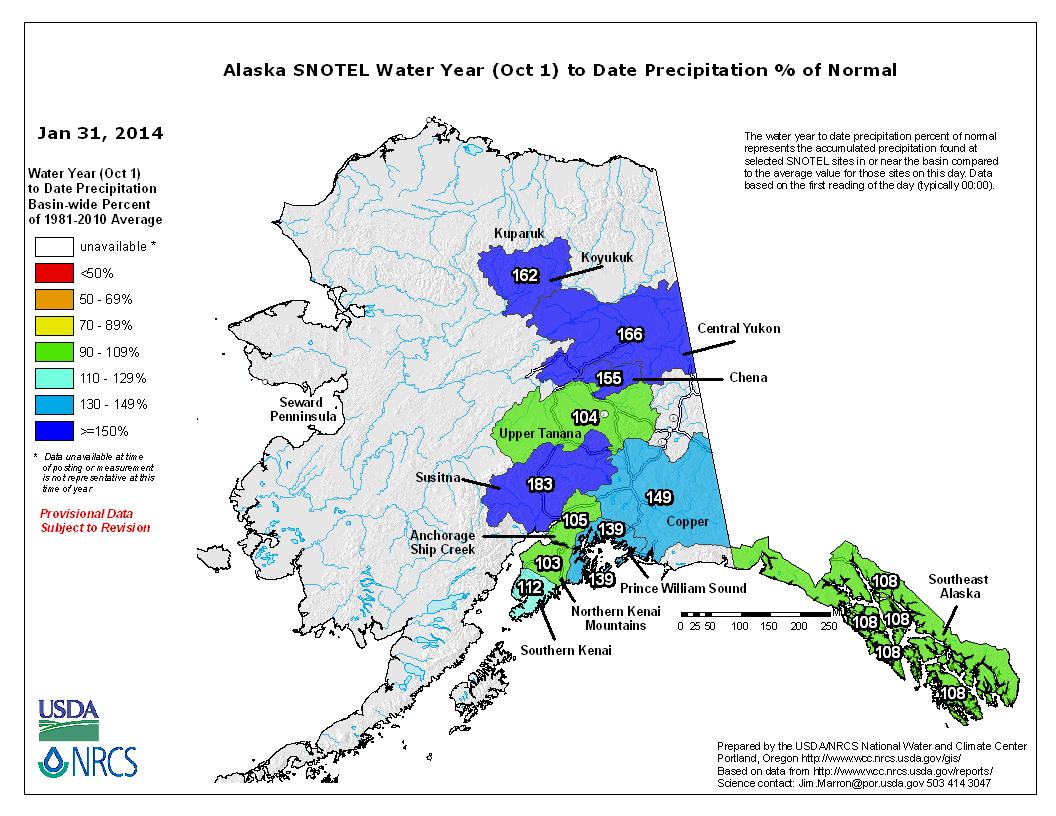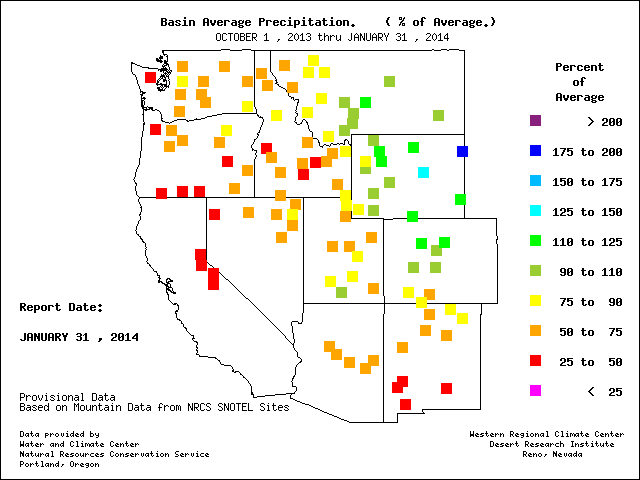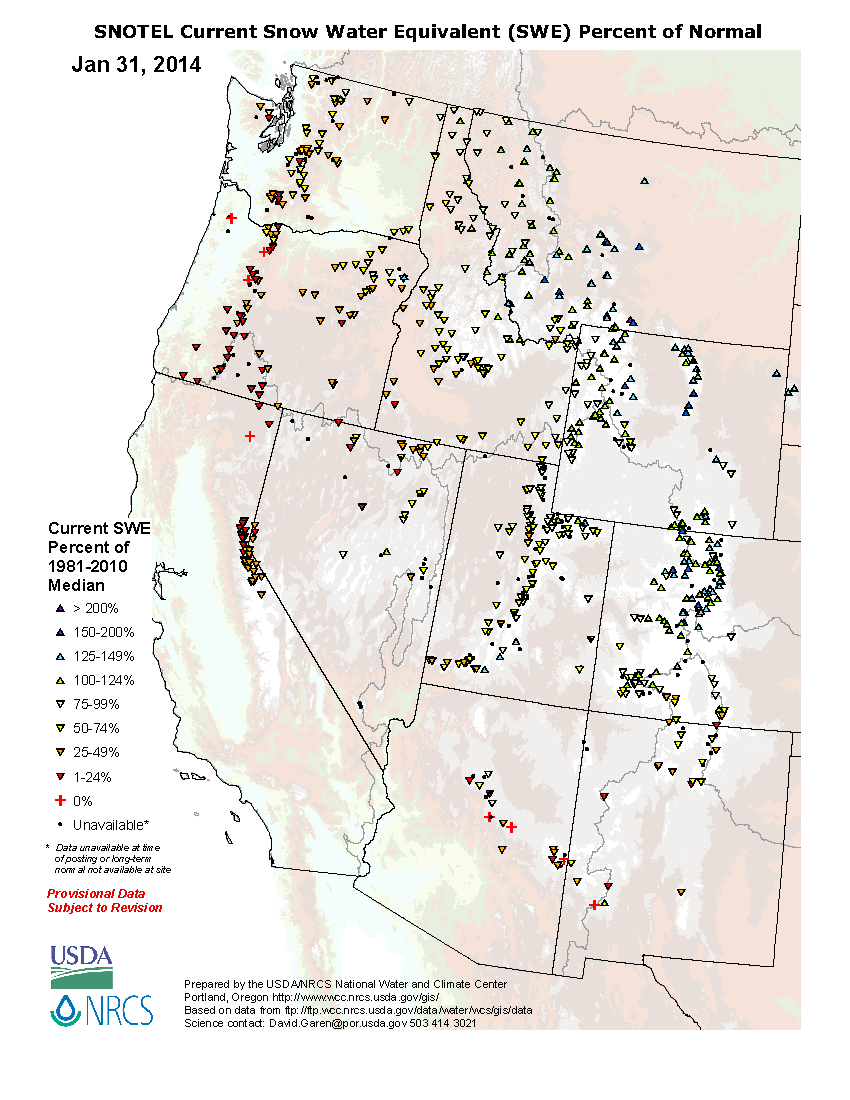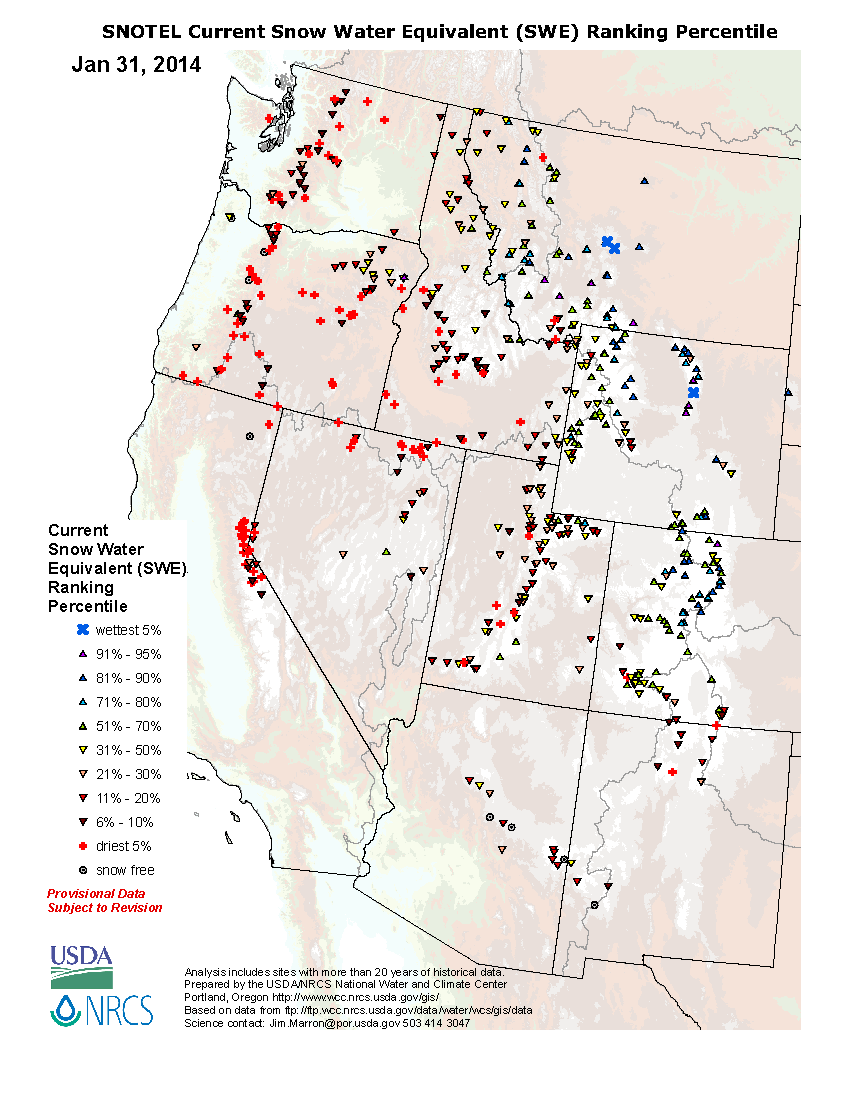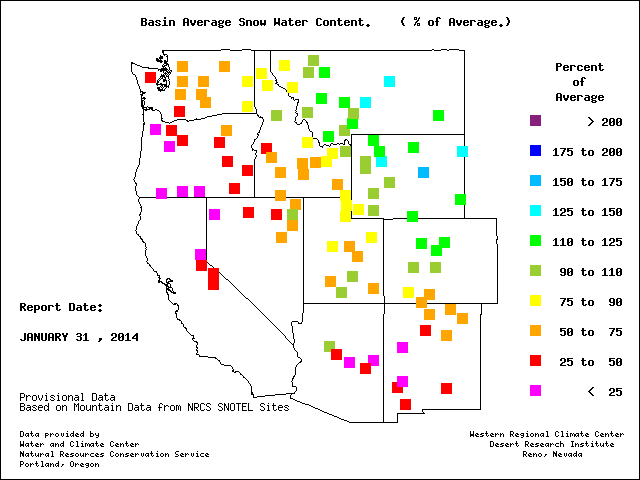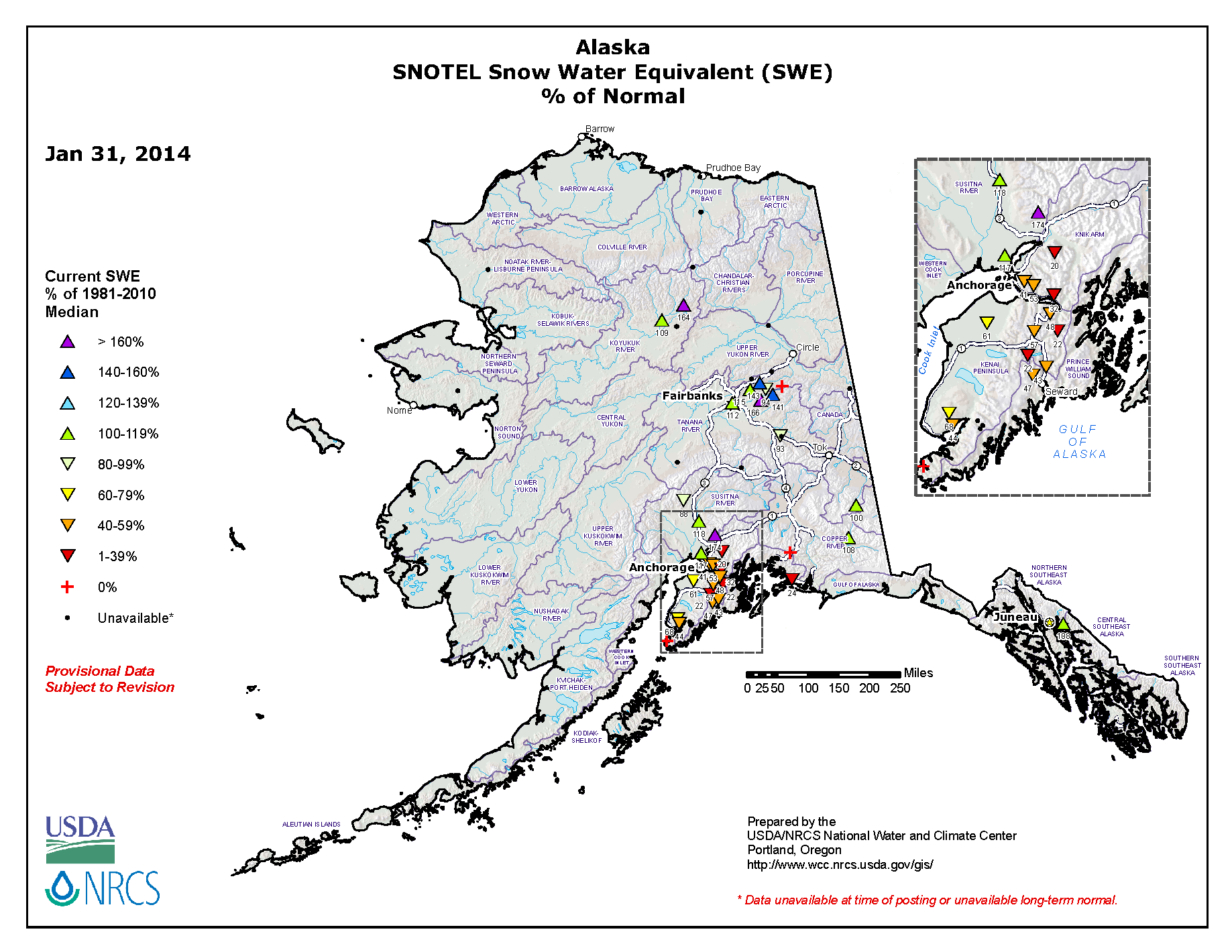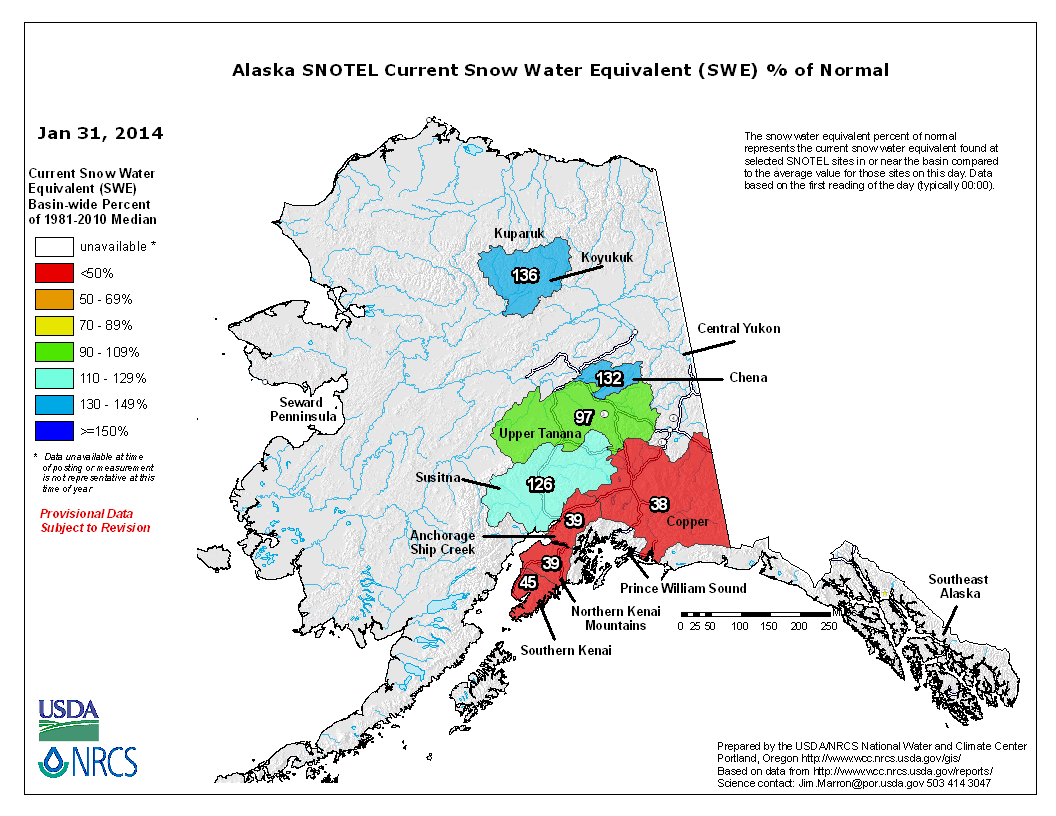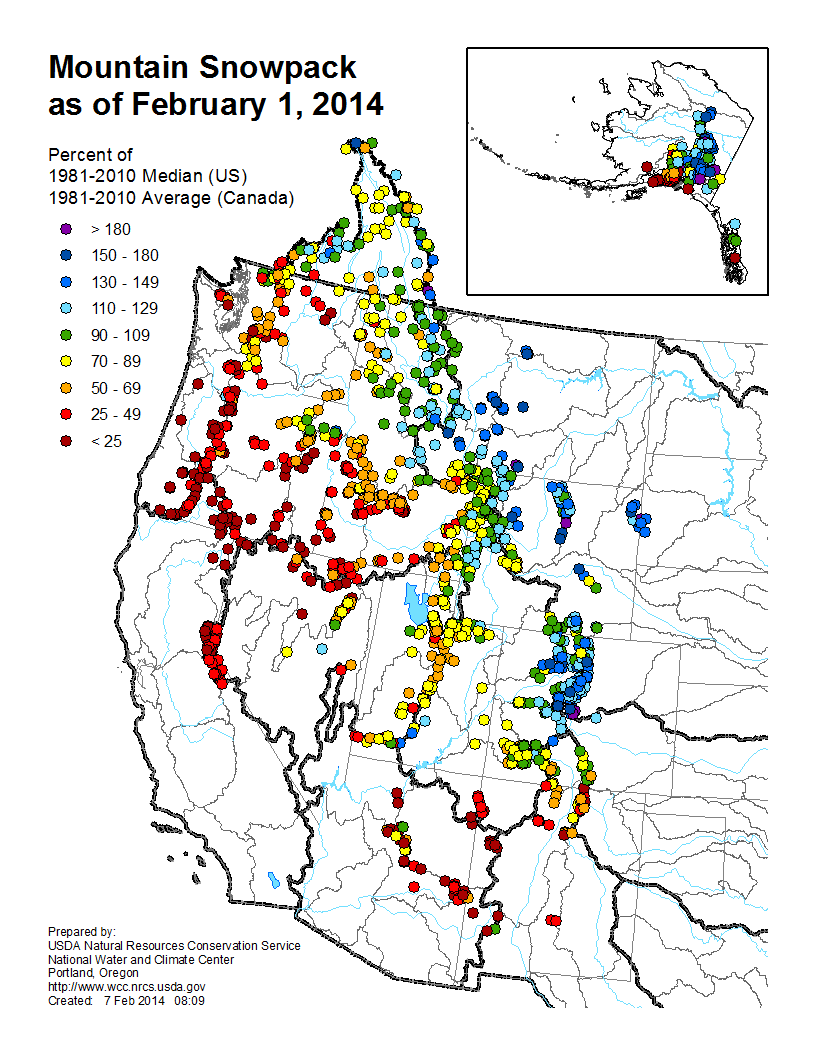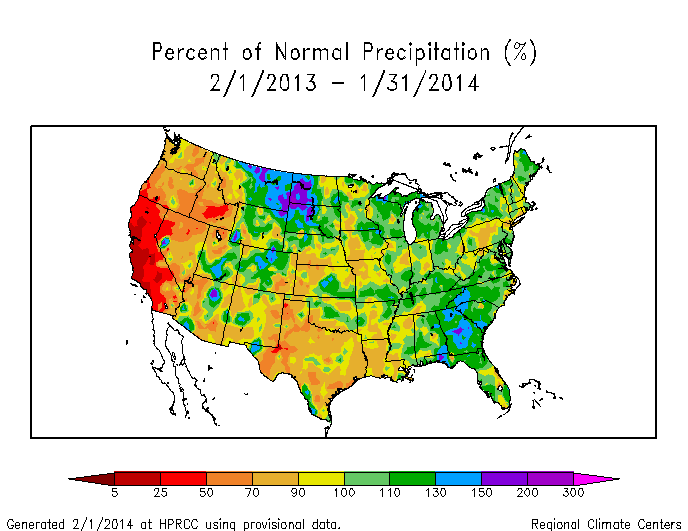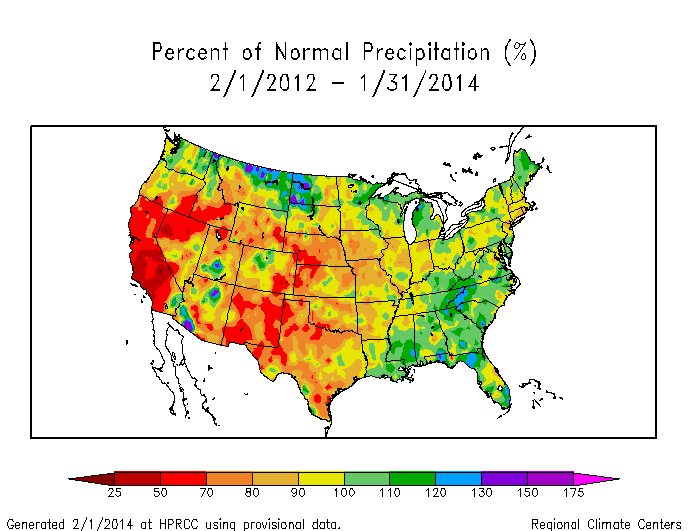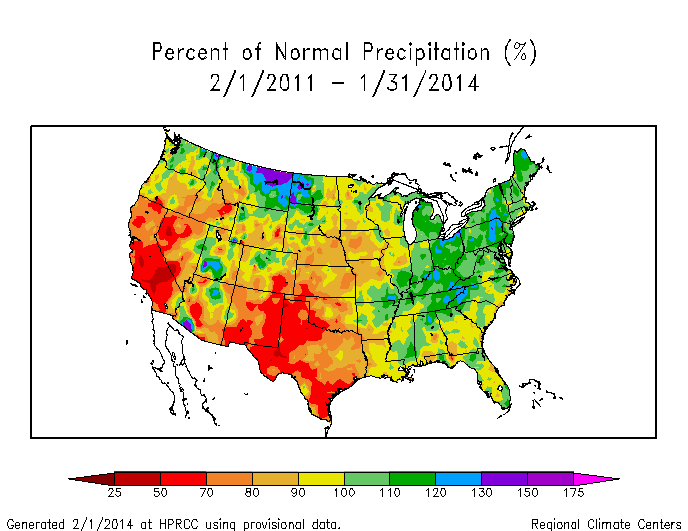|
Contents Of This Report: |
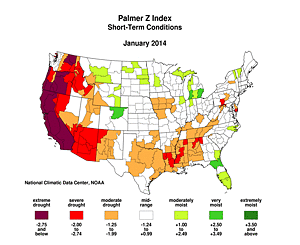
|
Please note that the values presented in this report are based on preliminary data. They will change when the final data are processed, but will not be replaced on these pages.
National Drought Overview
|
|
[top]
Detailed Drought Discussion
Overview
The upper-level circulation during January consisted of a long-wave ridge over the eastern North Pacific and western coast of North America, and a long-wave trough over eastern North America, with many wiggles, or short-wave troughs and ridges, migrating through the flow. The western ridge redirected weather systems into Alaska and created a northwesterly flow in the circulation which inhibited precipitation over the western CONUS, while storm systems caught up in the eastern trough produced precipitation east of the Rockies. The storm track resulted in only a few areas with above-normal precipitation: the High Plains and eastern slopes of the Rockies from Montana to Colorado, the Great Lakes region, and parts of the East Coast. Essentially no precipitation fell across much of the Southwest into the Southern Plains, and monthly precipitation was below normal across the rest of the West and Great Plains, and much of the Deep South, Ohio Valley, and Appalachian chain. Most of Alaska was wetter than normal, while beneficial rains fell over parts of the Hawaiian drought areas. When integrated across the country, January 2014 ranked as the fifth driest January in the 1895-2014 record. The precipitation eliminated drought in the Northeast, but January's dryness expanded drought in the Central and Southern Plains and West. On balance, the national drought footprint expanded over 5 percent to 31.3 percent of the U.S. as a whole, according to USDM statistics. According to the Palmer Drought Index, which goes back to the beginning of the 20th century, 24.5 percent of the CONUS was in moderate to extreme drought at the end of January, an increase of 6 percent compared to last month.
By the end of the month, the core drought areas in the U.S. included:
- a large area of drought in the West consisting of moderate (D1) to extreme (D3) drought with pockets of exceptional (D4) drought;
- areas of moderate to severe (D2) drought, with pockets of extreme to exceptional drought, from the Southern Plains to Central Plains, connected to the western drought by a bridge of moderate to severe drought across the Southwest;
- moderate to severe drought in the Midwest;
- moderate to severe drought in the western Gulf of Mexico coast; and
- Hawaii, where moderate to extreme drought persisted.
Palmer Drought Index
The Palmer drought indices measure the balance between moisture demand (evapotranspiration driven by temperature) and moisture supply (precipitation). The Palmer Z Index depicts moisture conditions for the current month, while the Palmer Hydrological Drought Index (PHDI) and Palmer Drought Severity Index (PDSI) depict the current month's cumulative moisture conditions integrated over the last several months. While both the PDSI and PHDI indices show long-term moisture conditions, the PDSI depicts meteorological drought while the PHDI depicts hydrological drought. The PDSI map shows less severe drought in the West than the PHDI map because the meteorological conditions that produce drought are not as long-lasting over much of the West as the hydrological impacts.
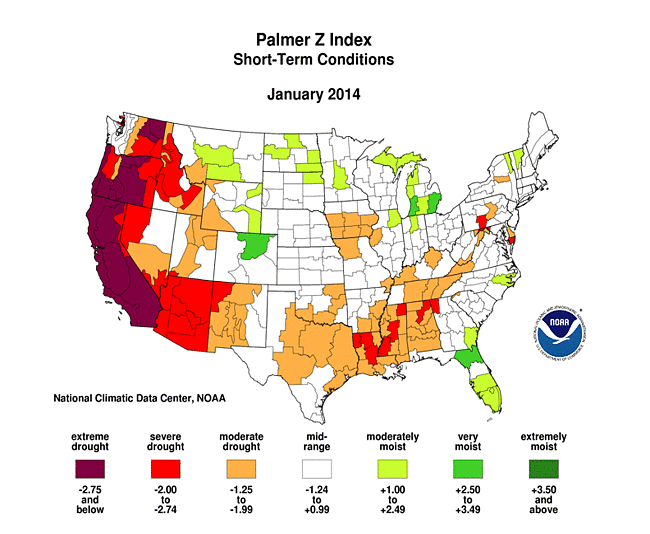 |
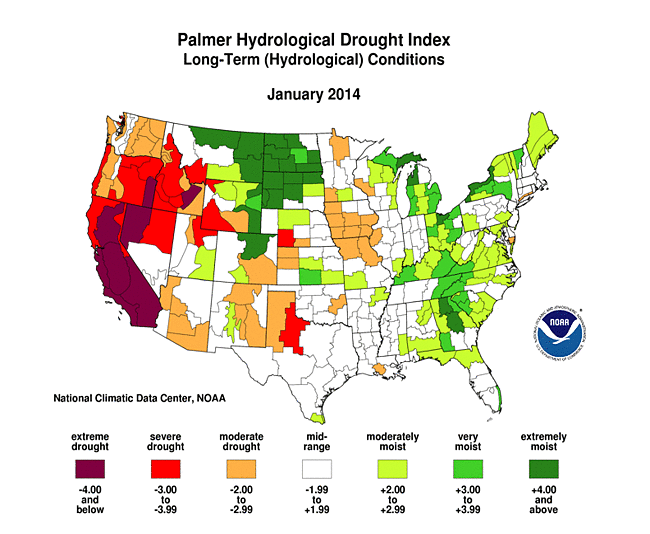 |
Used together, the Palmer Z Index and PHDI maps show that short-term dry conditions occurred during January over much of the West, Midwest, and Southern Plains which had areas in long-term drought conditions during December, resulting in an intensification and expansion of drought by the end of January. Short-term dry conditions also occurred during January over parts of the Southeast and Appalachians, where long-term wet spell conditions existed. Near normal to slightly wet short-term conditions occurred during January over the long-term wet spell areas of the Northern Plains and Great Lakes, resulting in little change in PHDI status there.
Standardized Precipitation Index
The Standardized Precipitation Index (SPI) measures moisture supply. The SPI maps here show the spatial extent of anomalously wet and dry areas at time scales ranging from 1 month to 24 months.
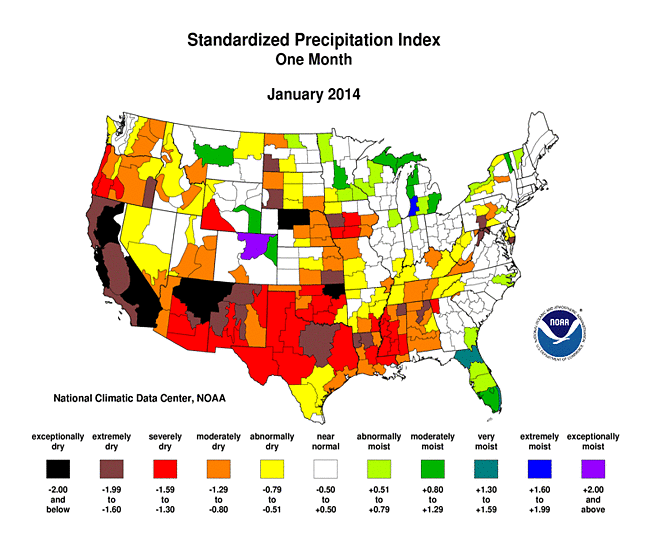 |
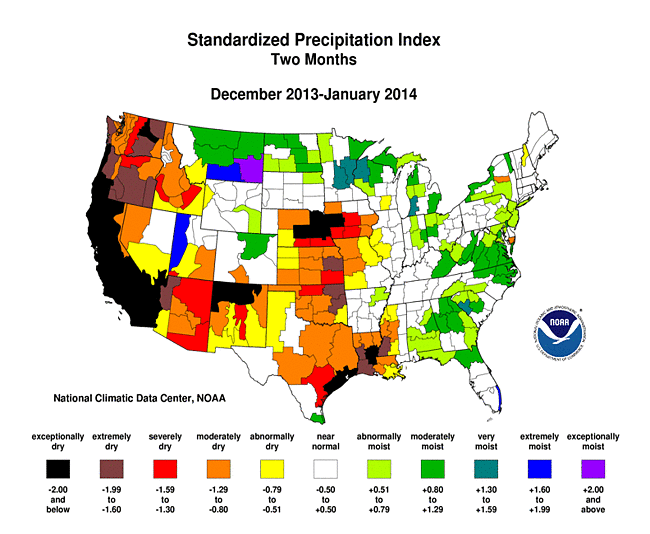 |
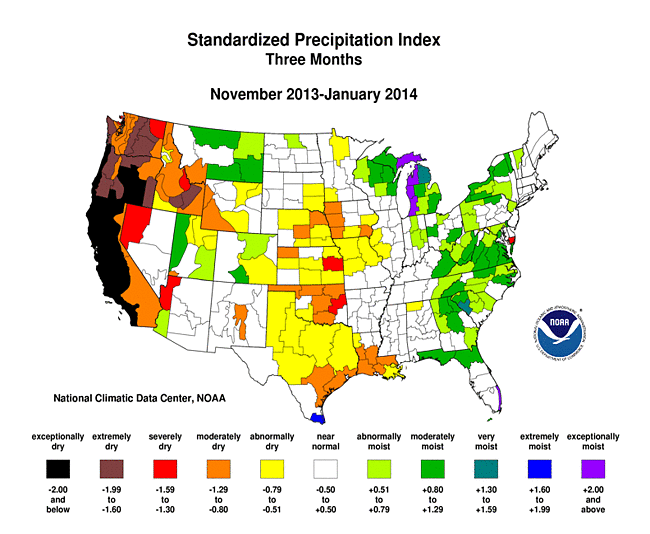 |
The SPI maps illustrate how moisture conditions have varied considerably through time and space over the last two years. Very dry conditions are evident across California and Nevada at every time scale from 1 to 24 months. The Pacific Northwest has been especially dry during the last 1 to 3 months (due to the upper-level ridge) and 12 months, but not as dry at the 9- and 24-month time scales, with the 6-month time scale appearing as a transition from very dry to not as dry. The Southwest shows up as dry at the 1- and 2-month time scales, wet at the 6- to 9-month time scales (due to monsoon showers), then neutral to dry at 24 months. The Central to Southern Plains and Midwest show up dry at 1 to 3 months, with the Midwest very dry at 6 months and slightly dry at 9 months. The Central to Southern Plains have a mixture of dry to wet areas at 6 to 12 months, but are mostly dry at 24 months (due to the severe 2012 drought). The Central Gulf of Mexico coast to Ohio Valley and Appalachians are dry at 1 month, but neutral to wet at longer time scales. Much of the East Coast is neutral with pockets of dryness at 1 and 6 months, but predominantly wet at the other time scales.
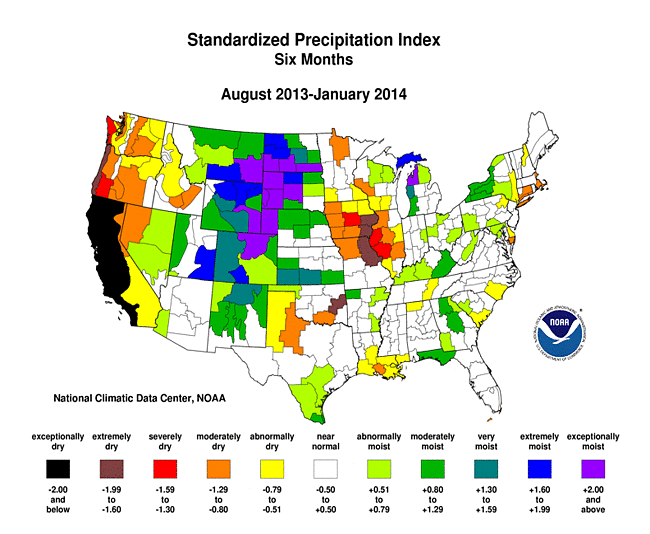 |
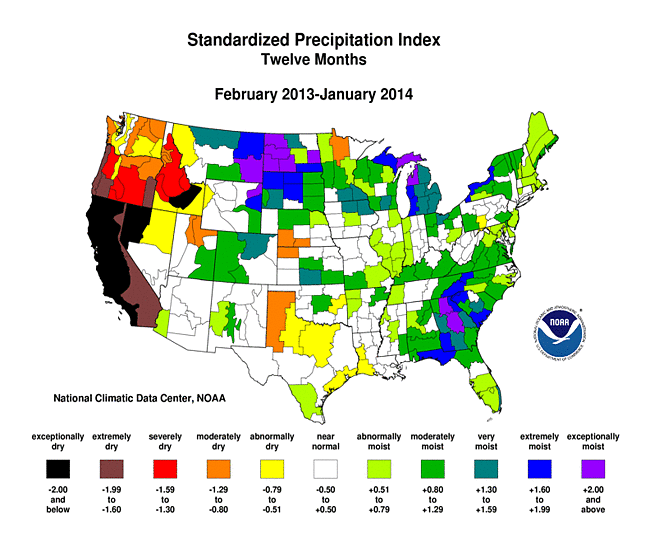 |
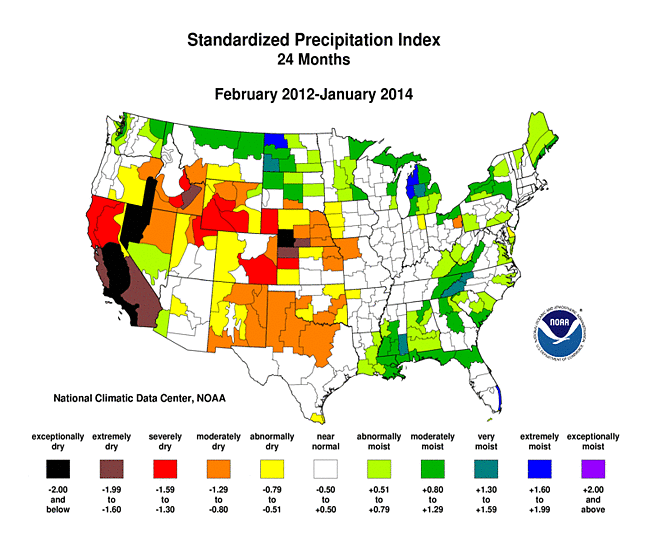 |
Agricultural, Hydrological, and Meteorological Indices and Impacts
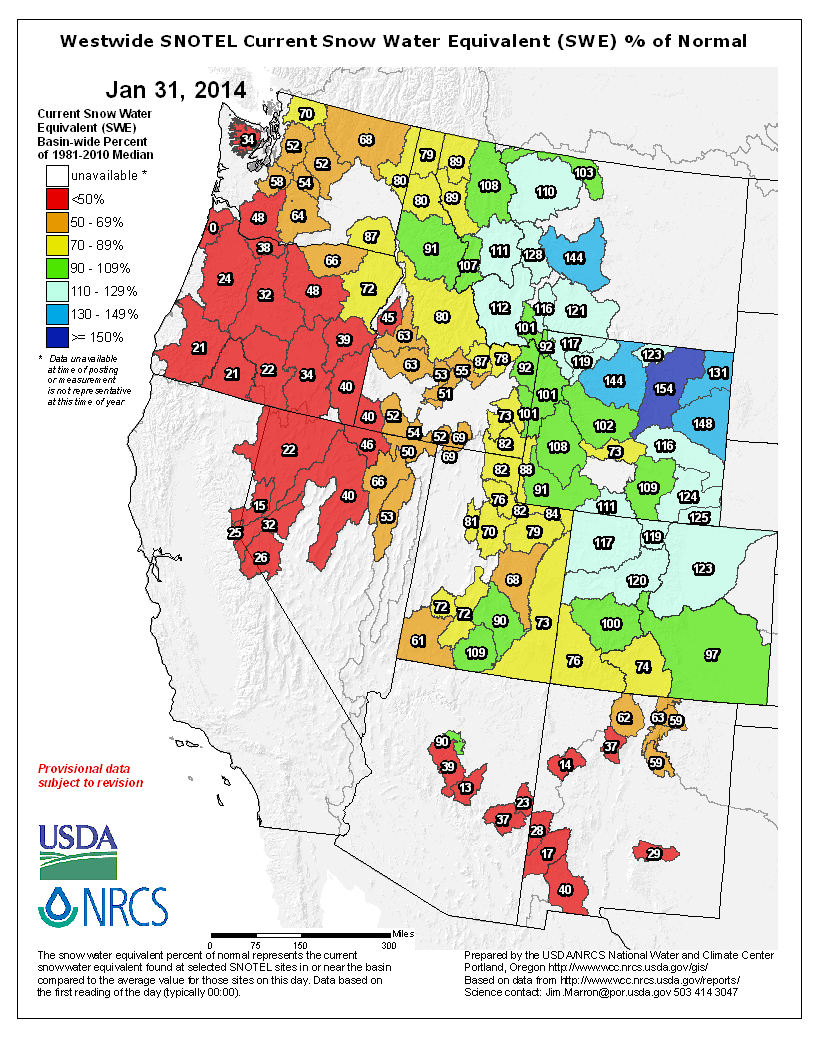 |
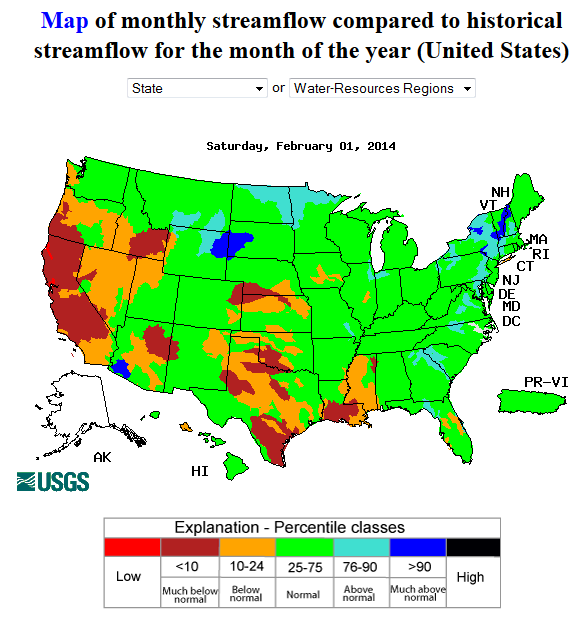 |
Drought conditions were reflected in numerous agricultural, hydrological, and other meteorological indicators, both observed and modeled.
Satellite observations (references 1, 2) showed vegetative stress continuing in parts of the West, especially California, but also in the Southern Plains, and this was confirmed by reports of non-irrigated crops suffering and lack of forage causing ranchers to cull their herds. According to the U.S. Department of Agriculture (USDA), as of February 4th, 49 percent of winter wheat, 40 percent of the domestic cattle inventory, 30 percent of corn acreage, 26 percent of hay acreage, and 21 percent of soybean acreage were in drought. These percentages are all increases compared to a month ago, with a +15 percent jump for winter wheat (although the decline in winter wheat conditions was partially due to dry, windy weather and sharp temperature fluctuations). According to the USDA, the portion of the wheat rated good to excellent fell during January from 70 to 60 percent in South Dakota; 65 to 46 percent in Nebraska; 60 to 46 percent in Montana; 63 to 36 percent in Oklahoma; and 58 to 35 percent in Kansas. Texas wheat, already stressed by drought, was rated 19 percent good to excellent and 41 percent very poor to poor by the end of January. Soil moisture was depleted across much of the Far West, Midwest, Southern Plains, and Deep South (4, 5, 6, 7, 8, 9, 11, 13), with the most rapid drying occurring in the West and Deep South (10, 12).
The lack of precipitation was reflected in below-normal monthly totals (33, 34, 35, 36, 37, 38, 39, 40, 41, 42, 43, 44, 45) as well as lack of rain days and long runs of consecutive dry days (50, 51). Streamflow in the West and parts of the Plains and Deep South averaged much below normal, with many California stream gauges measuring record low monthly values for January (17, 18, 22, 23, 24, 25). The persistent dryness — for the water year to date (October-January) (52, 53, 54, 55, 56, 57, 58, 59) and longer (80, 81, 82, 90, 91, 92) — was reflected in below-normal groundwater and springwater observations (26, 27, 28, 29, 30), snow cover and mountain snowpack and snow water content in the West (61, 62, 63, 64, 65, 66, 67), and, for California and most of the western states, below-normal reservoir levels.
Regional Discussion
Hawaii: The precipitation pattern for January 2014 was mixed across Hawaii. The pattern in the near term (last 2, 3, 4, and 6 months) generally consisted of drier-than-normal weather on one island and mixed conditions on the others, with the dry island changing from month to month. Drier-than-normal conditions tended to dominate at the longer time scales (last 7, 10, 12, 24, and 36 months). The rain that fell this month helped to shrink the moderate to extreme drought area from 49.6 percent last month to 22.2 percent this month. January streamflow was below normal on O'ahu.
Alaska: The weather pattern during January consisted of a strong and persistent upper-level ridge over the eastern Pacific Ocean which brought above-normal temperatures and mostly above-normal precipitation to Alaska. The above-normal precipitation is evident in both low elevation as well as high elevation (SNOTEL) stations. The warm temperatures and precipitation falling as rain instead of snow reduced the January snow water content in most basins compared to the end of December, with many southern stations having below-average snow water content. Most stations were wetter than normal in the near term (last 2, 3, 4, 6, and 7 months). Dryness at interior stations is evident at 10 to 12 months, with the pattern becoming mixed at longer time periods (last 24 to 36 months). There was some reduction in the area of abnormal dryness on the USDM map.
Puerto Rico: January was drier than normal for most of Puerto Rico, with this pattern also reflected at the 2-month time scale for the central to western parts of the island. Dryness is evident and persistent in the south central regions at longer time scales (last 3, 4, and 6 months). There was no change in the depiction of abnormal dryness on the USDM map.
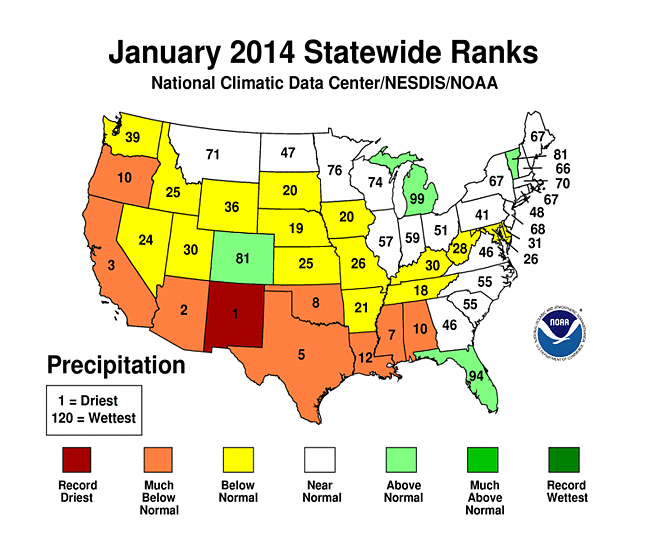 |
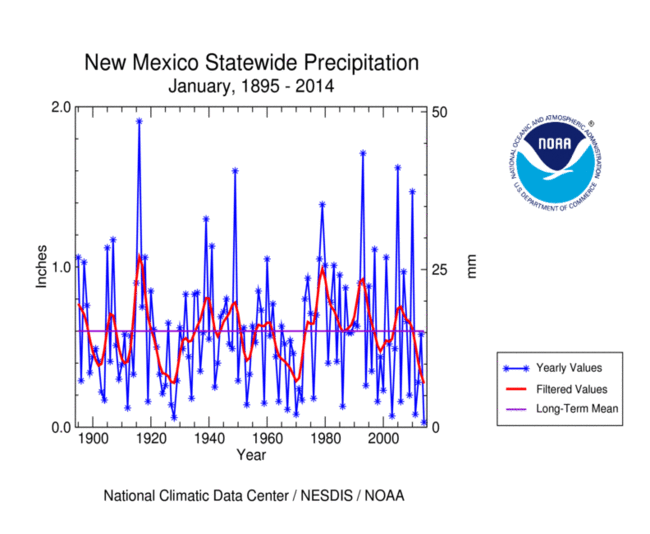
|
The January precipitation anomaly pattern of dryness in the West, Great Plains, South, and Appalachians was reflected in the state ranks, with 25 states having January precipitation ranks in the dry third of the historical record, eight of which ranked in the top ten driest category. New Mexico had the driest January in the 1895-2014 record, Arizona second driest, and California third driest.
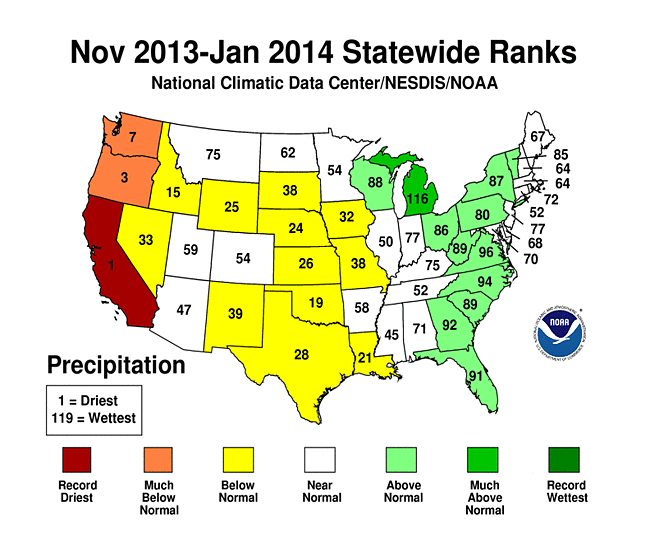 |
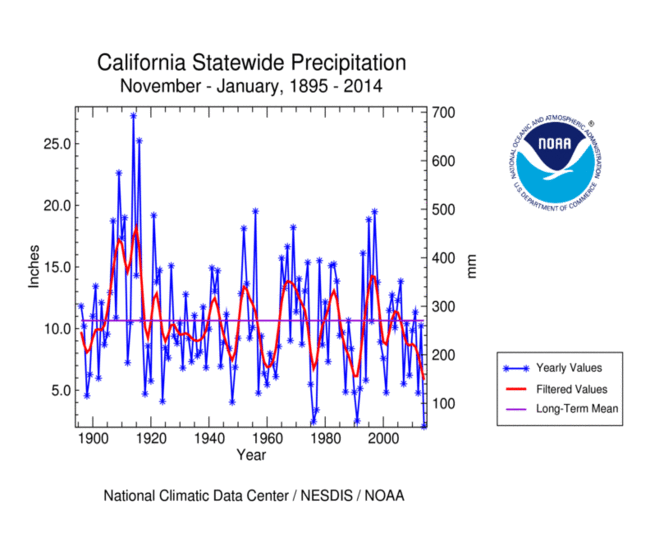
|
The November 2013-January 2014 precipitation anomaly pattern of dryness in the West, Great Plains, Midwest, and parts of the South was generally reflected in the state ranks. The three states along the West Coast had the tenth driest, or drier, November-January and twelve additional states (all west of the Mississippi River) ranked in the driest third of the historical record. California had the driest, Oregon third driest, and Washington seventh driest November-January in the 1895-2014 record.
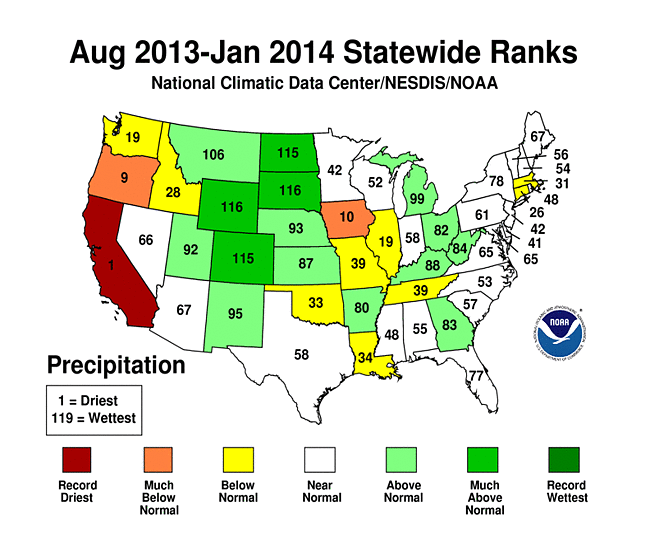
|
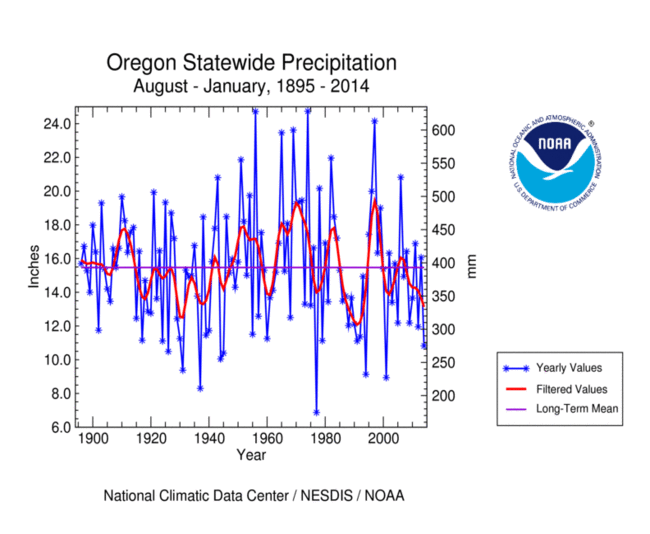
|
The primary dry areas during August 2013-January 2014 were the West Coast and Midwest, with areas of dryness intermingled with near- to above-normal areas in the South and along the East Coast. California had its driest August-January, Oregon ninth driest, and Iowa tenth driest. Nine other states (in the Northwest, Plains to Midwest, and New England) ranked in their driest third of the historical record.
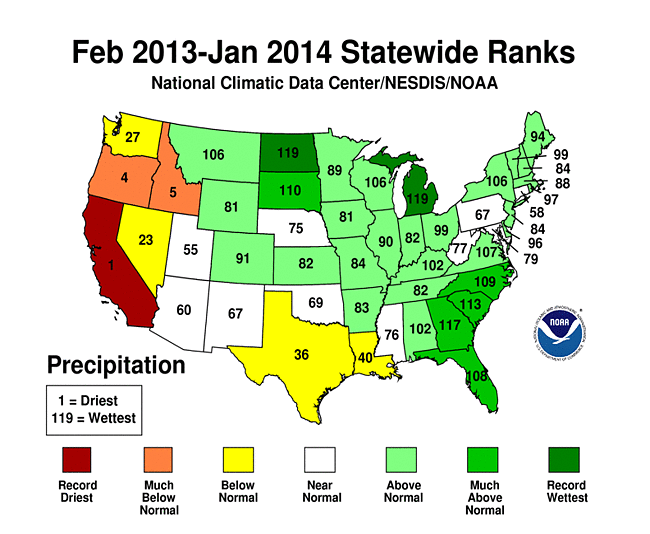
|
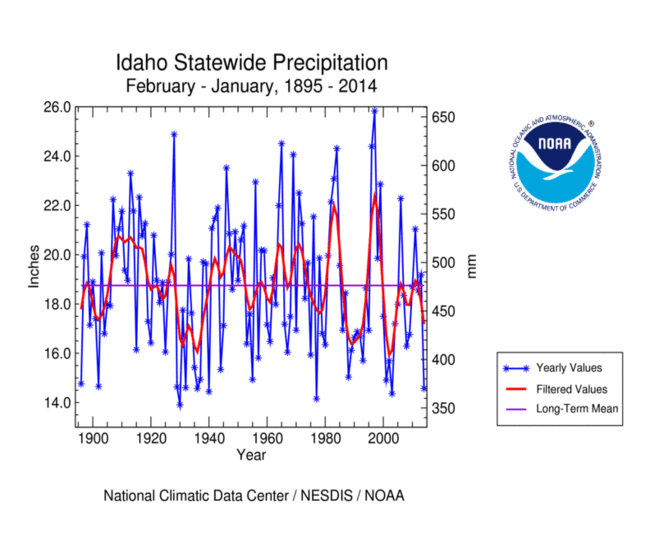
|
For the last twelve months (February 2013-January 2014), dryness dominated the West Coast and Pacific Northwest, and Central to Southern Plains, with patchy dry areas in the Southwest, Midwest, and Northeast. On the state rank map, California had the driest February-January on record, Oregon the fourth driest, and Idaho the fifth driest, with four other states (Nevada and Washington in the West and Louisiana and Texas in the South) ranking in the driest third of the historical record. States in the Southwest, Central Plains, Midwest, and Northeast ranked near- to above-normal because of pockets of wetter-than-average weather which influenced the statewide ranks.
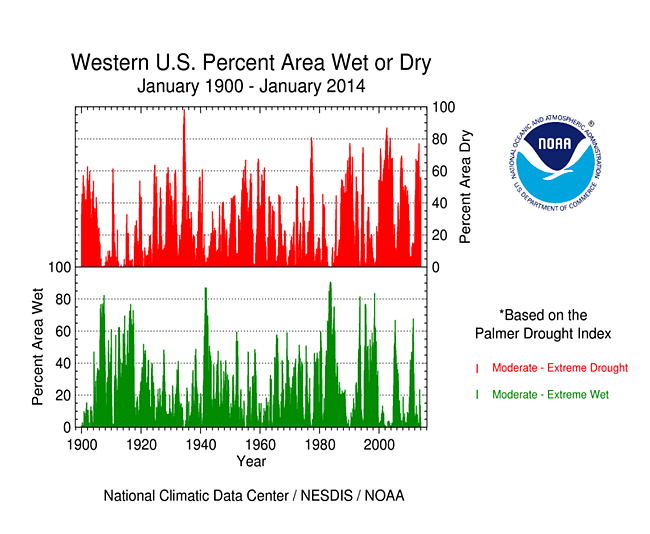 Percent area of the Western U.S. in moderate to extreme drought, January 1900 to present, based on the Palmer Drought Index. As noted above, dry weather has dominated the West for the last several months, resulting in reduced mountain snowpack and lake, reservoir, and stream levels. According to the USDM, 63.5 percent of the West was experiencing moderate to exceptional drought at the end of January, an increase of about 12.1 percent compared to the previous month. The Palmer Drought Index percent area statistic was 55.7 percent, an increase of about 15.3 percentage points from the previous month. |
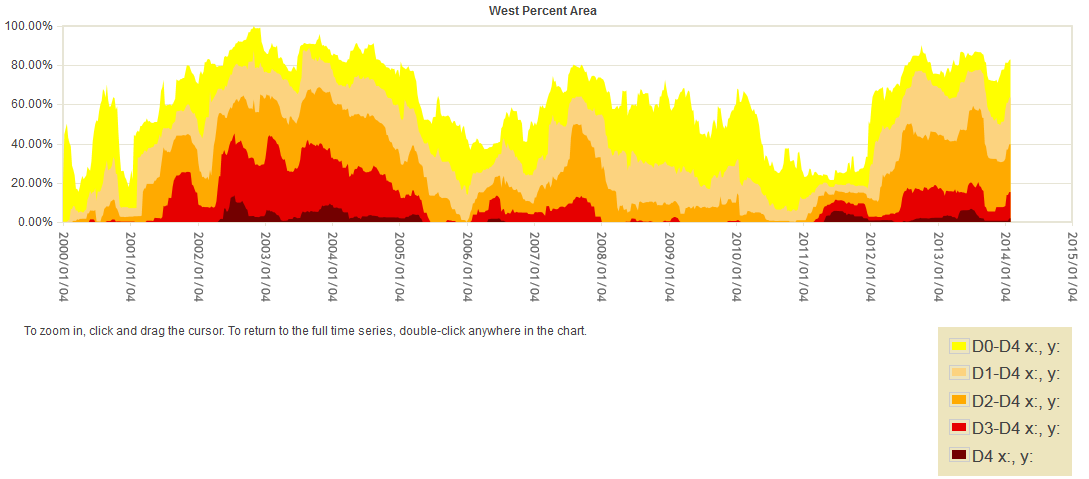
|
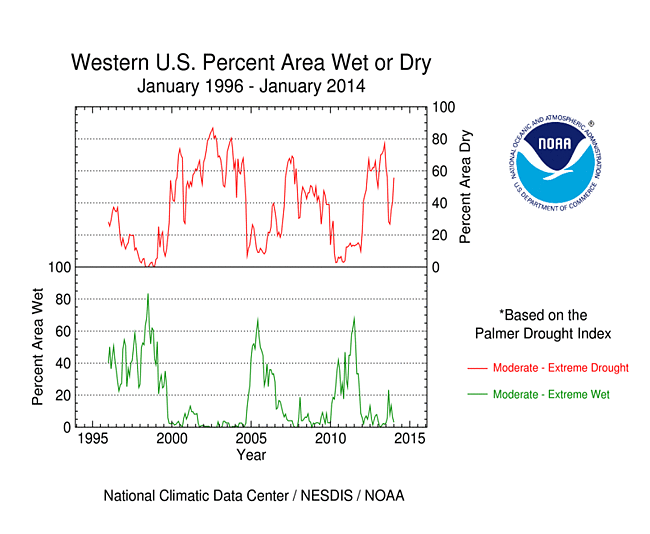
|
|
of Months |
|
|
|
|
Jan 2014 |
12 months |
|
|
Jan 2014 |
24 months |
|
|
Jan 2014 |
36 months |
|
|
Jan 2014 |
48 months |
|
|
Jan 2014 |
60 months |
California has been especially hard hit. Except for January 2014 (third driest) and June 2013-January 2014 (second driest), all of the time periods from the last two months (December 2013-January 2014) through the last twelve months (February 2013-January 2014) have ranked driest on record. In addition to the last twelve months (February 2013-January 2014) being the driest such 12-month period in the 1895-2014 record, the last five years (60 months) have been extremely dry (see table to right). More of the state (67.1 percent) is in extreme drought than ever before in the 15-year record for the USDM, and this is the first time in the USDM record that the state has experienced exceptional drought (D4). The statewide Palmer Z Index has indicated severe short-term drought for eleven of the last 13 months, with the persistent and extreme dryness causing the California statewide PDSI to reach values rivalling the most severe droughts of the 20th century (1990-91, 1976-77, and 1924).
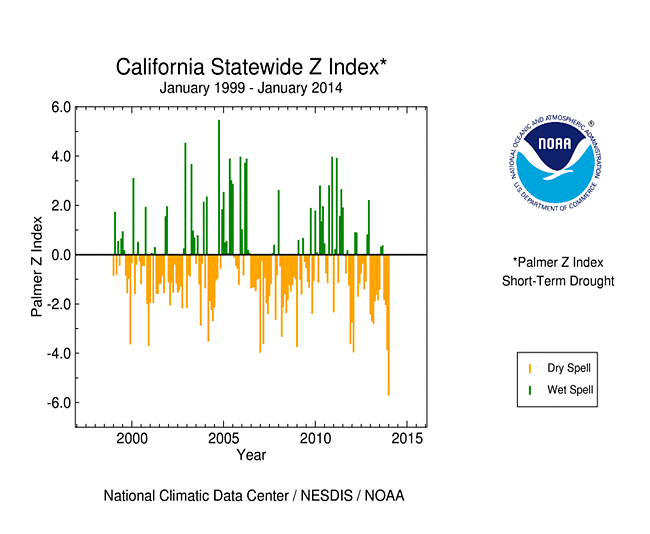
|
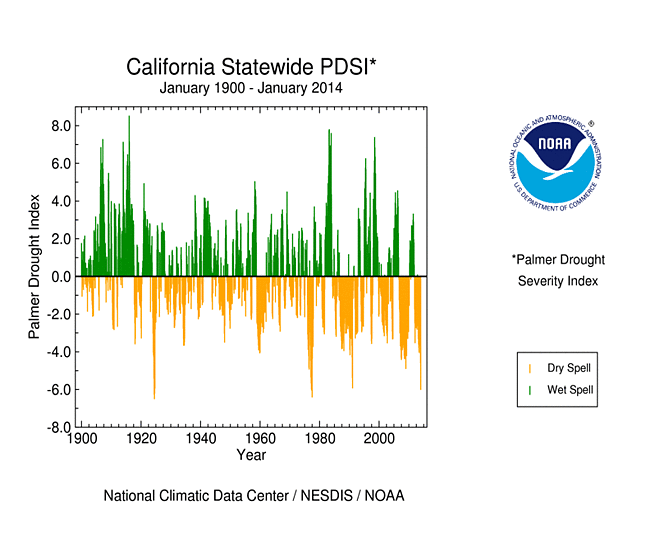 |
If not for the beneficial warm season monsoon rains last year, the conditions in New Mexico would be equally dire. But even last year's beneficial precipitation was not enough to erase deficits which have built up over several years. The last twelve months (February 2013-January 2014) ranked as the 67th driest (53rd wettest) such 12-month period, but the previous year (February 2012-January 2013) was second driest (behind February 1956-January 1957). The last 24 months (February 2012-January 2014) ranked as the 14th driest such 24-month period, but last year (February 2011-January 2013) ranked second driest, again behind 1956-57. The last 36 months (February 2011-January 2014) ranked as the sixth driest such 36-month period, with 2010-2013 (February 2010-January 2013) ranking seventh driest. The last 48 months (February 2010-January 2014) was the eleventh driest such 48-month period, and the last 60 months ranked 13th driest.
Primary Hard Red Winter Wheat Agricultural Belt
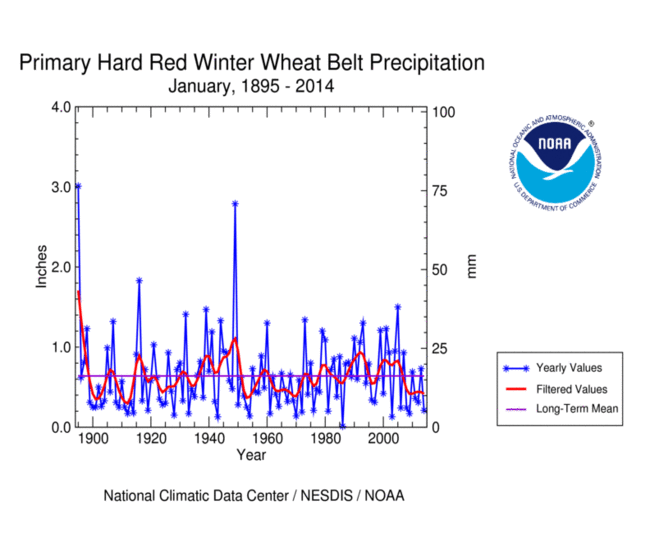
|
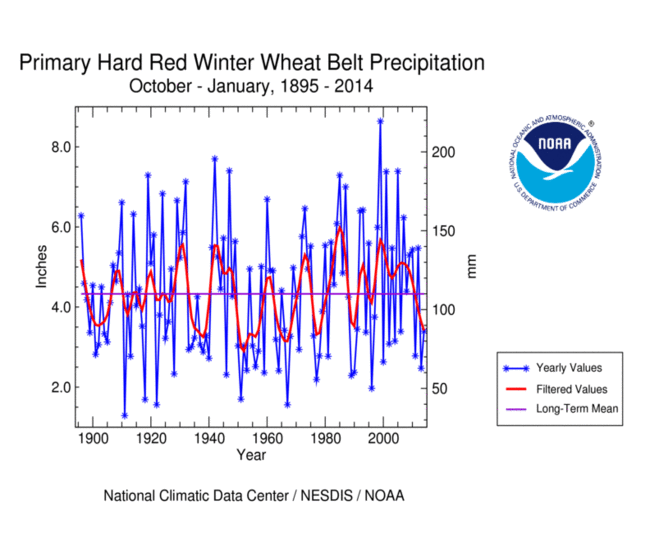 |
The January precipitation pattern for the Primary Hard Red Winter Wheat agricultural belt was much drier than normal, especially in the southern regions, with January 2014 ranking 14th driest and 56th warmest region-wide. The growing season to date (October 1-present) ranked as the 47th driest and 29th coolest October-January. However, long-term dryness lingered, with the PHDI and USDM indicating widespread moderate drought and pockets of severe to exceptional drought. The last twelve months (February 2013-January 2014) ranked as the 60th driest (60th wettest) such 12-month period in the 119-year record for the Primary Hard Red Winter Wheat belt, but the previous year (February 2012-January 2013) was the fifth driest such 12-month period. The last 24 months (February 2012-January 2014) ranked as the 16th driest such 24-month period, with the previous year (2011-2013) ranking eighth driest. The last 36 months (February 2011-January 2014) ranked as the 13th driest such 36-month period, with the previous year (2010-2013) right behind at 14th driest. The last 48 months (February 2010-January 2014) ranked as the 16th driest such 48-month period, and the last 60 months (February 2009-January 2014) ranked as the 22nd driest such 60-month (5-year) period. The driest for each of these time periods was 1957, with many years from the 1950s and 1930s in the top ten driest category for each.
NOAA Regional Climate Centers:
A more detailed drought discussion, provided by the NOAA Regional Climate Centers and others, can be found below.
West — Pacific Islands
As described by the High Plains Regional Climate Center, the High Plains region experienced quite a range in temperatures this month with a combination of both warm spring-like days and bitterly cold days. Individual days also had quite the diurnal range. In the end, most of the High Plains region averaged out to near normal with above normal temperatures generally in the west and below normal temperatures in the east. Precipitation was sparse for most of the High Plains region this month. Large areas of Kansas, Nebraska, South Dakota, and North Dakota were dry with precipitation totals less than 50 percent of normal. Additionally, areas of southern and eastern Kansas, eastern and northern Nebraska, and southern South Dakota received less than 25 percent of normal precipitation. The ongoing dryness in Kansas and Colorado continued to have impacts. A mid-month dust storm in the Pueblo, Colorado area caused several accidents and closed I-25 for a portion of the day. A similar scene played out just a few days later in northwestern Kansas where a dust storm reduced visibilities, caused accidents, and closed I-70 for several hours. These are just two examples of dust storms that occurred in these drought-stricken areas this month.
Some locations within the dry areas of the region experienced quite a "snow drought" this month as even areas in the Deep South received more snowfall. Luckily, since winter is typically the driest part of the year, precipitation deficits have not increased drastically. A lack of snow cover can have its advantages, however, this year the multiple extreme cold events combined with a lack of snow cover may be a risk to the winter wheat crop in Kansas and Nebraska. Not all areas of the region were lacking snowfall this month. Areas receiving above normal precipitation included northern Colorado along with pockets of Wyoming and North Dakota. Across the western U.S., this season's snowpack has been a story of the haves and the have-nots. Generally, eastern areas have fared well, while many areas to the west have struggled due to higher than normal temperatures and drought conditions. For instance, snowpack in California and Oregon has been abysmal so far this season and reservoirs have been in severe decline. Luckily, places like northern Colorado and much of Wyoming have fared better, especially when compared to last year. By the end of the month, Wyoming's statewide snowpack was 113 percent of average and Colorado's statewide snowpack was 94 percent of average. In contrast, last year's snowpack was 76 percent of average and 75 percent of average, respectively.
There were only small changes to the USDM in the High Plains region this month. Approximately 23 percent of the Region was in moderate (D1) to exceptional (D4) drought at the end of January, which was a slight increase from 21 percent at the end of December. Degradations were present in southwestern Colorado and across Kansas. In Kansas, higher than normal temperatures combined with dry and windy conditions led to an expansion of drought there. Both areas of extreme drought (D3) expanded to the west, while areas of severe (D2) and moderate (D1) drought expanded to the east. Abnormally dry conditions (D0) also expanded eastward. By the end of the month, 63 percent of the state was in drought, which was quite a difference from last month's 47 percent.
As explained by the Southern Regional Climate Center, January was a very dry month for the Southern region as well as being very cold for the entire region. Most of the region saw precipitation totals that were less than half of normal. In Arkansas and Tennessee, precipitation totals varied between 50 to 70 percent of expected values. Throughout most of Louisiana and Mississippi, precipitation totals ranged between one fourth and half of normal for the month. Conditions were even drier in Texas and Oklahoma. Much of the western half of Texas experienced an extremely dry month, with precipitation totals ranging from zero to five percent of normal. Many stations, in that area, reported no precipitation at all. For the state of Texas, it was the fifth driest January on record (1895-2014), while Mississippi and Oklahoma reported their seventh and eighth driest January on record, respectively. Louisiana experienced their twelfth driest January on record, and Tennessee saw its eighteenth driest on record. For Arkansas, it was the twenty-first driest January on record. The period of record for all of the states is 1895-2014.
Drought conditions over the month of January remained relatively unchanged, despite it being very dry across the region. In Louisiana, a small area of moderate drought was added in the south central portions of the state. There was also some moderate drought added along the Texas Gulf coast region. In Texas, many lakes across the state are at dangerous levels, including the Highland Lakes, which are at a combined 38% capacity. This is raising concerns that water prices across the Lower Colorado River Authority region could increase by 20% next year. The low water supply levels became evident when the State Comptroller's Office released a statement on January 17 reporting that 23,000 Texans are at risk to losing water service within 45 days and another 47,000 running that risk at 90 days. The USDA placed 180 counties within the state under a Natural Disaster Declaration, giving farmers and ranchers the option to apply for low interest rate federal loans to make up for losses. The Panhandle from 2010-2013 has surpassed the 1954-1956 time period as the record driest three year period on record. Wichita Falls, still under Stage 4 water restrictions, is considering a cloud seeding project that could cost more than $50,000 per month. In the Panhandle, cold temperatures combined with the lack of short-term rain have many winter wheat growers fearful that a large-scale crop die-off is imminent (Information provided by the Texas Office of State Climatology).
As summarized by the Midwest Regional Climate Center, January precipitation was below normal for most of the Midwest, especially in the south and west with some above normal readings around the Great Lakes, and temperatures were well below normal across the region. Precipitation totals were less than 50 percent of normal in parts of Missouri and Iowa with western Iowa totals less than 25 percent of normal. Despite the lower precipitation totals, snowfall totals were above normal for much of the region as several snow storms tracked across the region in January.
As noted by the Southeast Regional Climate Center, precipitation in January was below average across much of the Southeast region, except across the Florida Peninsula where precipitation was generally above average for the month, and it was an exceptionally cold month across much of the region. The greatest precipitation deficits were found across Alabama, where monthly precipitation totals were as much as 3 to 5 inches (76.2 to 127.0 mm) below average. Precipitation was also below average across Puerto Rico and the U.S. Virgin Islands, where monthly deficits of 1 to 4 inches (25.4 to 101.6 mm) were observed. Monthly totals were 1 to 2 inches (25.4 to 50.8 mm) below average across much of Georgia and the Carolinas, except along a swath stretching across central South Carolina and south-central North Carolina where strong thunderstorms dropped between 2 and 4 inches (50.8 and 101.6 mm) of rain on the 11th of the month. There were relatively few changes made to the USDM across the Southeast in January. The lack of rain over the past few months across the Deep South resulted in an expansion of abnormally dry (D0) conditions into northern, southern, and western sections of Alabama. Abnormally dry conditions continued to persist across extreme southeastern North Carolina and parts of South Florida where winter season precipitation deficits have been the greatest. According to the Florida State Climate Office, the cold outbreak and high winds early in the month caused some damage to winter oats and vegetable crops across the central and southern parts of the state, while the cold temperatures in the wake of the winter storm at the end of the month resulted in more widespread damage to crops across the Panhandle region.
As explained by the Northeast Regional Climate Center, this January was a chilly one in the Northeast. With an average temperature of 19.5 degrees F (-6.9 degrees C), it was 4.1 degrees F (2.3 degrees C) cooler than normal. The Northeast returned to drier-than-normal conditions in January. The region received 2.76 inches (70.10 mm) of precipitation, 89 percent of normal. Nine of the twelve states were drier than normal, with departures ranging from 74 percent of normal in Maryland and West Virginia to 96 percent of normal in New York. New Hampshire finished the month at 102 percent of normal, while Vermont and Maine received 111 percent of normal. According to the USDM released on January 2, 23 percent of the Northeast was abnormally dry while 7 percent was under moderate drought conditions. Precipitation throughout the month eased dryness and by month's end, 11 percent of the Northeast was abnormally dry and the areas of moderate drought had been removed.
As summarized by the Western Regional Climate Center, a strong and persistent ridge over the West Coast kept coastal states much warmer and drier than normal this month, exacerbating drought conditions that have developed over the past 30 months. The position of the ridge allowed storms to move through the northern and central Rocky Mountains, bringing above normal precipitation there.
Above normal temperatures dominated the West this month following a cooler than normal December. Many stations in California broke long-standing temperature records. Below normal precipitation accompanied this month's above normal temperatures, expanding drought conditions in many western states and prompting a drought State of Emergency declaration by the Governor of California. At the beginning of the month 27.5% of California was categorized as D3 or D4 (extreme to exceptional drought) by the USDM. By the end of January, this figure rose to 67%. In southern California, Los Angeles received no measurable January precipitation. Since records began in 1878, this has only occurred in four other years. Sacramento set a record for the longest spell of consecutive stretch with no rain at 52 days, from December 7-January 29. With a total of 0.22 in (5 mm), this January was the 3rd driest since Sacramento's records began in 1877. San Francisco saw only 0.06 in (2 mm) of rain this for the driest January in the past 166 years. Normal January precipitation in San Francisco is 4.5 in (114 mm). Drought conditions also worsened in northern Nevada, Oregon, Washington, Idaho, Arizona and New Mexico this month. In Arizona, Flagstaff had a run of 39 days (December 22-January 29) without precipitation, the longest winter dry streak in the station's 87 years of data. Albuquerque, New Mexico, also received no measurable January precipitation for the 9th time since 1897. In the Northwest, Medford, Oregon, recorded 0.78 in (20 mm) for the month, the 7th driest in a 103-year record. Yakima, Washington saw only 0.3 in (8 mm) precipitation this month, the 9th driest January in a 68-year record.
At month's end, snowpack was very low in the northern Great Basin and coastal states. These regions saw snow water equivalent (SWE) values less than 75% of normal with a low of 15% of normal in the Lake Tahoe Basin of the Sierra Nevada. SWE values increased to the east, with basins in Utah and Idaho measured SWE values 50-100% of normal. Further east, most basins in western Montana, Wyoming, and Colorado had SWE values over 100% of normal. In Colorado, 14.3 in (36 cm) of snow fell in Denver for the 11th snowiest January on record. Cheyenne, Wyoming logged its 6th wettest January in a 100-year record with 1.01 in (26 mm) precipitation. Billings, Montana saw its 11th snowiest January in the past 80 years, with 18.2 in (46 cm) of snowfall this month. This winter is the 5th snowiest at Billings thus far at 55.8 in (142 cm).
Dry conditions permitted several fires to char California this month. In southern California, the Colby Fire, destroyed five residences and 10 buildings and burned 1952 acres (790 hectares). The Mission Fire in Jurupa Valley, fanned by Santa Ana winds, demolished four homes. Further north, the Soda Fire burned 1274 acres (516 hectares) in Sequoia National Forest. In northern California, the Campbell Fire charred 865 acres (350 hectares) in Lassen National Forest.
Above normal temperatures and precipitation were observed throughout Alaska this month. In the South Central region of the state, Gulkana recorded 1.79 in (45 mm) precipitation for the month for its wettest January in the past 72 years. It was also the 2nd warmest January at Gulkana, where temperatures averaged to 18.5 F (-7.5 C), 21.4 F (12 C) above normal. In the central part of the state, McGrath also recorded its 2nd warmest January average at 13.5 F (-10.3 C), 20 F (11 C) above normal.
Pacific Islands: According to reports from National Weather Service offices, the Pacific ENSO Applications Climate Center (PEAC), and partners, conditions varied across the Pacific Islands.
As noted by the National Weather Service office in Honolulu, several cold fronts during January were able to move across the island chain and reach the Big Island. These fronts brought much needed rain to the west-facing slopes and helped improve pasture and general vegetation conditions. Most of the drought areas across Maui County and the Big Island improved by at least one-category on the USDM map over the past month. Extreme drought, or the D3 category, eased to severe drought, or the D2 category over the Pohakuloa area of the Big Island and the Kihei area of Maui. The only D3 area left in the state covered portions of western Molokai serviced by the Kualapuu reservoir. Moderate drought, or the D1 category, has been reduced in size and covered the lower leeward slopes of west Maui from Lahaina to Maalaea, and on the Big Island from the lower leeward south Kohala slopes to the Humuula Saddle and the upper slopes of Mauna Loa. Kauai County and Oahu remain drought-free.
Some drought impacts impacts in Hawaii include the following:
KAUAI. THERE ARE NO DROUGHT IMPACTS TO REPORT. OAHU. THERE ARE NO DROUGHT IMPACTS TO REPORT. MOLOKAI. THE WATER LEVEL IN THE KUALAPUU RESERVOIR HAS CONTINUED TO INCREASE SLOWLY IN RECENT WEEKS BUT REMAINS LESS THAN HALF OF CAPACITY. AS A RESULT...THE STATE OF HAWAII DEPARTMENT OF AGRICULTURE HAS CONTINUED ITS MANDATORY 30 PERCENT REDUCTION IN IRRIGATION WATER USE. LANAI. SATELLITE-BASED DATA SHOWED A REDUCTION IN STRESS ON VEGETATION HEALTH OVER THE PAST SEVERAL WEEKS AND A GAGE IN THE WESTERN SIDE OF THE ISLAND REPORTED AN ABOVE AVERAGE JANUARY RAINFALL TOTAL. MAUI. PASTURE CONDITIONS HAVE IMPROVED OVER THE PAST MONTH AS A RESULT OF THE RECENT BOOST IN RAINFALL. HOWEVER...THE U.S. DEPARTMENT OF AGRICULTURE REPORTED AN INCREASE IN FIRE WEED GROWTH DUE TO THE INCREASE IN RAINFALL WHICH PRODUCES A DIFFERENT SET OF PROBLEMS. WATER LEVELS IN RESERVOIRS SUPPLYING RESIDENTS IN THE UPCOUNTRY AREA OF THE ISLAND HAVE ALSO INCREASED. THE MAUI COUNTY DEPARTMENT OF WATER SUPPLY HAS CONTINUED ITS LONG STANDING REQUEST FOR CENTRAL AND SOUTH MAUI RESIDENTS TO VOLUNTARILY REDUCE CONSUMPTION BY 10 PERCENT. BIG ISLAND. PASTURE CONDITIONS HAVE BEEN IMPROVING OVER THE PAST MONTH AND EVEN FLOODING IN SOME CASES. THIS IS CONSISTENT WITH SATELLITE-BASED DATA WHICH SHOWED REDUCED VEGETATION STRESS OVER THE LEEWARD SLOPES. FOLLOW-UP RAINFALL IS NEEDED TO SUSTAIN THE RECOVERY...ESPECIALLY WITH THE DRY SEASON NOT TOO FAR OFF.
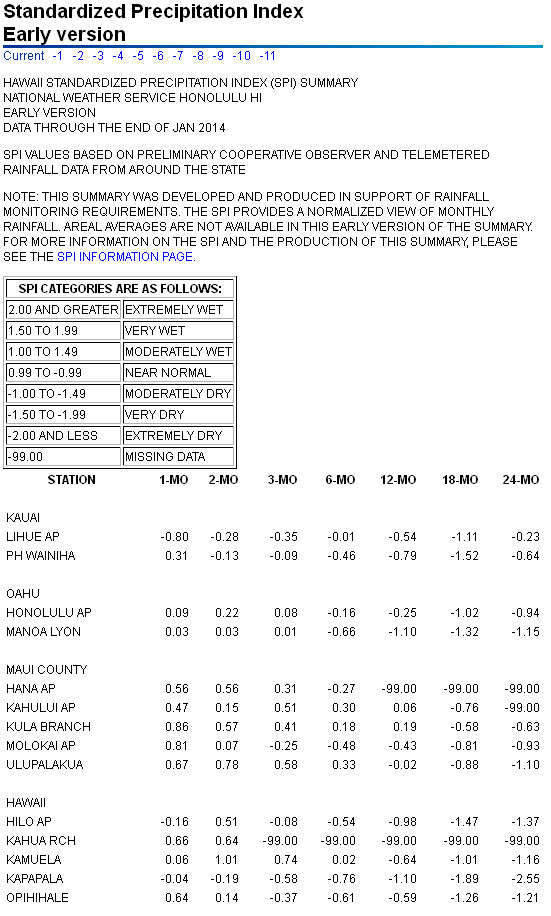
On other Pacific Islands (maps — Micronesia, Marshall Islands, basinwide), January 2014 was drier than normal at Chuuk, Kosrae, and Pohnpei, and wetter than normal at all other reporting stations. The January rainfall amounts were below 8 inches (a critical threshold amount) at Chuuk and Kwajalein, and above 8 inches at the other stations. The northern Marshall Islands have been especially dry. The monthly precipitation was below 8 inches at Kwajalein for the last two months (2.62 inches in December and 3.81 inches in January) and for eight of the last twelve months. Rainfall for January (through the 29th) at Utirik was 0.56 inch and at Wotje was 0.66 inch, with December totals 0.49 inch at Utirik and 1.28 inches at Wotje. The monthly precipitation was below 8 inches at Utirik for nine of the last twelve months and at Wotje for seven of the last twelve months.
Several stations in the region experienced persistent dryness at some point in the last twelve months. The November-January, August-January, and February-January multi-month totals were all drier than normal for Kwajalein and Majuro in the Republic of the Marshall Islands, and Chuuk and Pohnpei in the Federated States of Micronesia.
| Station Name | Feb 2013 | Mar 2013 | Apr 2013 | May 2013 | Jun 2013 | Jul 2013 | Aug 2013 | Sep 2013 | Oct 2013 | Nov 2013 | Dec 2013 | Jan 2014 | Feb- Jan |
|---|---|---|---|---|---|---|---|---|---|---|---|---|---|
| Chuuk | 146% | 192% | 49% | 79% | 84% | 84% | 80% | 141% | 103% | 111% | 75% | 59% | 92% |
| Guam NAS | 97% | 191% | 45% | 103% | 102% | 53% | 74% | 255% | 198% | 56% | 65% | 421% | 114% |
| Kapingamarangi | 154% | 199% | 77% | 48% | 47% | 50% | 83% | 55% | 85% | 38% | 254% | 168% | 89% |
| Koror | 92% | 56% | 103% | 109% | 67% | 64% | 99% | 64% | 86% | 115% | 64% | 170% | 82% |
| Kosrae | 146% | 64% | 95% | 76% | 122% | 69% | 62% | 104% | 201% | 112% | 87% | 86% | 83% |
| Kwajalein | 17% | 74% | 178% | 29% | 67% | 98% | 57% | 82% | 37% | 121% | 39% | 121% | 73% |
| Lukonor | 134% | 122% | 71% | 92% | 64% | 37% | 62% | 117% | 118% | 125% | 90% | 257% | 88% |
| Majuro | 152% | 78% | 69% | 65% | 96% | 103% | 65% | 87% | 71% | 96% | 51% | 125% | 84% |
| Pago Pago | 87% | 93% | 144% | 66% | 220% | 153% | 337% | 125% | 62% | 58% | 99% | 146% | 104% |
| Pohnpei | 54% | 67% | 59% | 52% | 113% | 61% | 38% | 121% | 81% | 142% | 36% | 78% | 72% |
| Saipan | 78% | 127% | 63% | 203% | 157% | 50% | 53% | 167% | 109% | 52% | 71% | 546% | 108% |
| Yap | 113% | 130% | 50% | 69% | 134% | 53% | 86% | 181% | 144% | 74% | 65% | 340% | 110% |
| Station Name | Feb 2013 | Mar 2013 | Apr 2013 | May 2013 | Jun 2013 | Jul 2013 | Aug 2013 | Sep 2013 | Oct 2013 | Nov 2013 | Dec 2013 | Jan 2014 | Feb- Jan |
|---|---|---|---|---|---|---|---|---|---|---|---|---|---|
| Chuuk | 10.60" | 16.00" | 6.11" | 8.93" | 9.85" | 10.04" | 10.25" | 16.49" | 11.82" | 11.82" | 8.44" | 5.98" | 126.33" |
| Guam NAS | 2.95" | 3.95" | 1.14" | 3.51" | 6.32" | 5.39" | 10.84" | 32.25" | 22.66" | 4.13" | 3.33" | 16.89" | 113.36" |
| Kapingamarangi | 14.25" | 22.79" | 10.51" | 5.84" | 6.45" | 7.11" | 6.72" | 5.42" | 6.99" | 3.49" | 25.02" | 15.38" | 129.97" |
| Koror | 7.91" | 4.13" | 7.57" | 12.87" | 11.70" | 11.94" | 13.35" | 7.53" | 10.19" | 13.11" | 7.19" | 17.27" | 124.76" |
| Kosrae | 18.89" | 10.20" | 16.71" | 13.41" | 17.89" | 10.33" | 8.80" | 14.82" | 22.03" | 15.54" | 13.94" | 14.39" | 176.95" |
| Kwajalein | 0.46" | 1.73" | 9.34" | 1.97" | 4.66" | 9.71" | 5.51" | 8.81" | 4.17" | 13.63" | 2.62" | 3.81" | 66.42" |
| Lukonor | 11.93" | 11.34" | 8.06" | 10.77" | 7.51" | 5.88" | 8.64" | 11.92" | 13.34" | 11.38" | 10.11" | 21.65" | 132.53" |
| Majuro | 10.44" | 5.13" | 6.46" | 6.60" | 10.55" | 11.51" | 7.62" | 9.70" | 9.01" | 12.84" | 5.76" | 9.66" | 105.28" |
| Pago Pago | 10.48" | 9.97" | 13.52" | 6.35" | 11.75" | 8.48" | 18.14" | 8.14" | 5.71" | 5.91" | 12.71" | 19.54" | 130.7" |
| Pohnpei | 5.14" | 8.78" | 10.92" | 10.44" | 16.79" | 9.42" | 5.41" | 15.23" | 12.37" | 20.99" | 5.79" | 10.27" | 131.55" |
| Saipan | 2.03" | 2.40" | 1.65" | 4.82" | 5.68" | 4.42" | 6.99" | 16.87" | 11.60" | 2.91" | 2.74" | 13.81" | 75.92" |
| Yap | 5.86" | 5.95" | 2.81" | 5.41" | 16.16" | 8.01" | 12.69" | 24.39" | 17.60" | 6.56" | 5.56" | 21.74" | 132.74" |
| Station Name | Feb 2013 | Mar 2013 | Apr 2013 | May 2013 | Jun 2013 | Jul 2013 | Aug 2013 | Sep 2013 | Oct 2013 | Nov 2013 | Dec 2013 | Jan 2014 | Feb- Jan |
|---|---|---|---|---|---|---|---|---|---|---|---|---|---|
| Chuuk | 7.25" | 8.32" | 12.47" | 11.30" | 11.66" | 11.98" | 12.86" | 11.71" | 11.51" | 10.61" | 11.25" | 10.10" | 136.77" |
| Guam NAS | 3.03" | 2.07" | 2.53" | 3.40" | 6.18" | 10.14" | 14.74" | 12.66" | 11.44" | 7.38" | 5.11" | 4.01" | 99.09" |
| Kapingamarangi | 9.27" | 11.43" | 13.64" | 12.08" | 13.78" | 14.15" | 8.13" | 9.93" | 8.19" | 9.27" | 9.84" | 9.15" | 145.85" |
| Koror | 8.56" | 7.44" | 7.32" | 11.83" | 17.48" | 18.53" | 13.50" | 11.77" | 11.84" | 11.39" | 11.16" | 10.18" | 152.90" |
| Kosrae | 12.93" | 16.06" | 17.51" | 17.75" | 14.64" | 14.91" | 14.22" | 14.22" | 10.94" | 13.83" | 16.11" | 16.67" | 213.87" |
| Kwajalein | 2.64" | 2.35" | 5.26" | 6.72" | 6.93" | 9.87" | 9.74" | 10.74" | 11.18" | 11.28" | 6.66" | 3.16" | 90.41" |
| Lukonor | 8.93" | 9.26" | 11.31" | 11.69" | 11.65" | 15.93" | 14.04" | 10.15" | 11.32" | 9.08" | 11.27" | 8.41" | 151.36" |
| Majuro | 6.88" | 6.58" | 9.42" | 10.11" | 11.01" | 11.17" | 11.69" | 11.17" | 12.73" | 13.44" | 11.39" | 7.74" | 125.25" |
| Pago Pago | 12.00" | 10.68" | 9.39" | 9.66" | 5.33" | 5.55" | 5.38" | 6.53" | 9.26" | 10.14" | 12.84" | 13.34" | 125.57" |
| Pohnpei | 9.55" | 13.17" | 18.41" | 19.96" | 14.81" | 15.43" | 14.26" | 12.55" | 15.27" | 14.83" | 16.08" | 13.18" | 182.36" |
| Saipan | 2.59" | 1.89" | 2.63" | 2.38" | 3.62" | 8.91" | 13.13" | 10.09" | 10.62" | 5.61" | 3.85" | 2.53" | 70.25" |
| Yap | 5.19" | 4.56" | 5.63" | 7.85" | 12.04" | 15.08" | 14.82" | 13.50" | 12.18" | 8.83" | 8.51" | 6.39" | 120.31" |
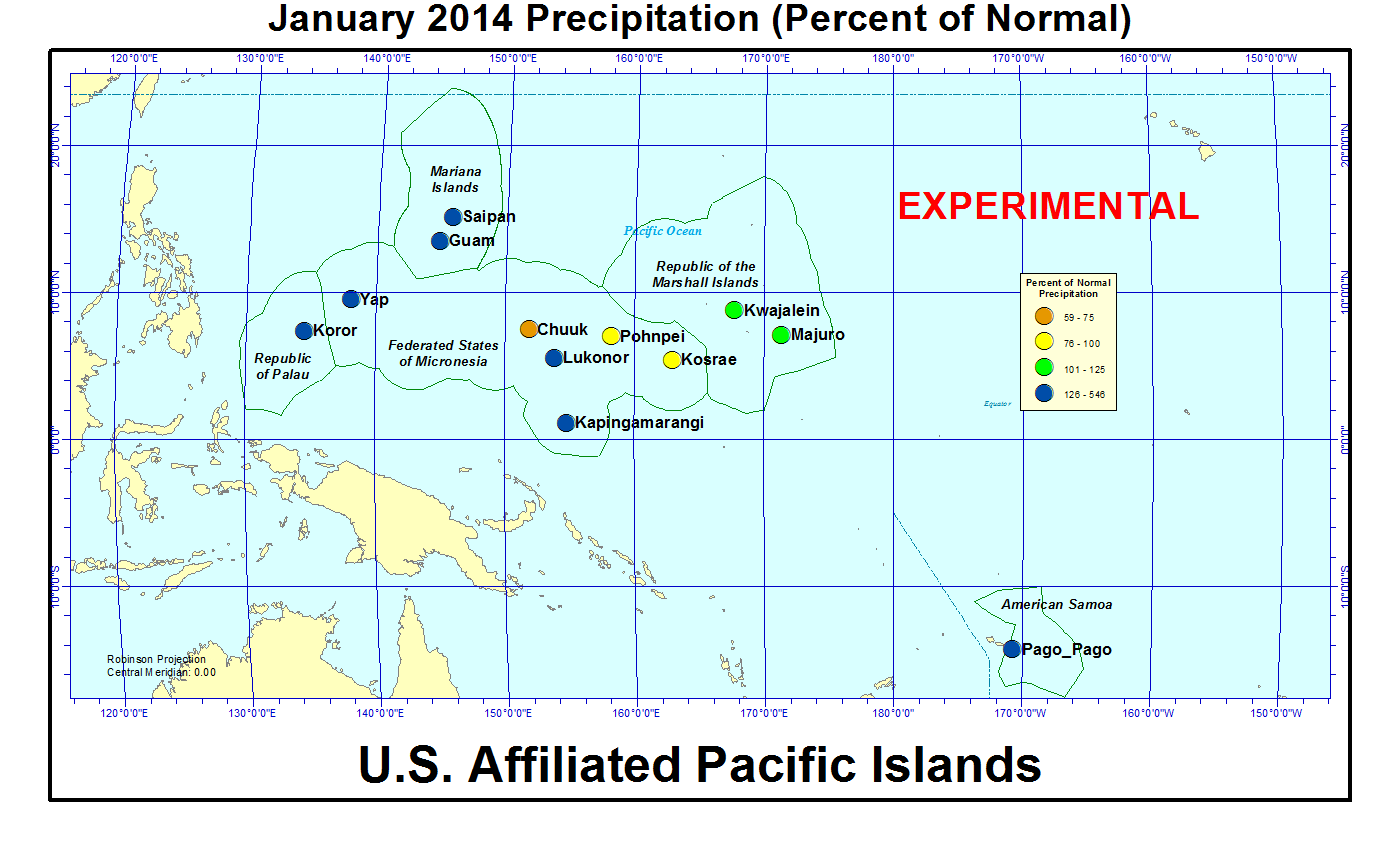
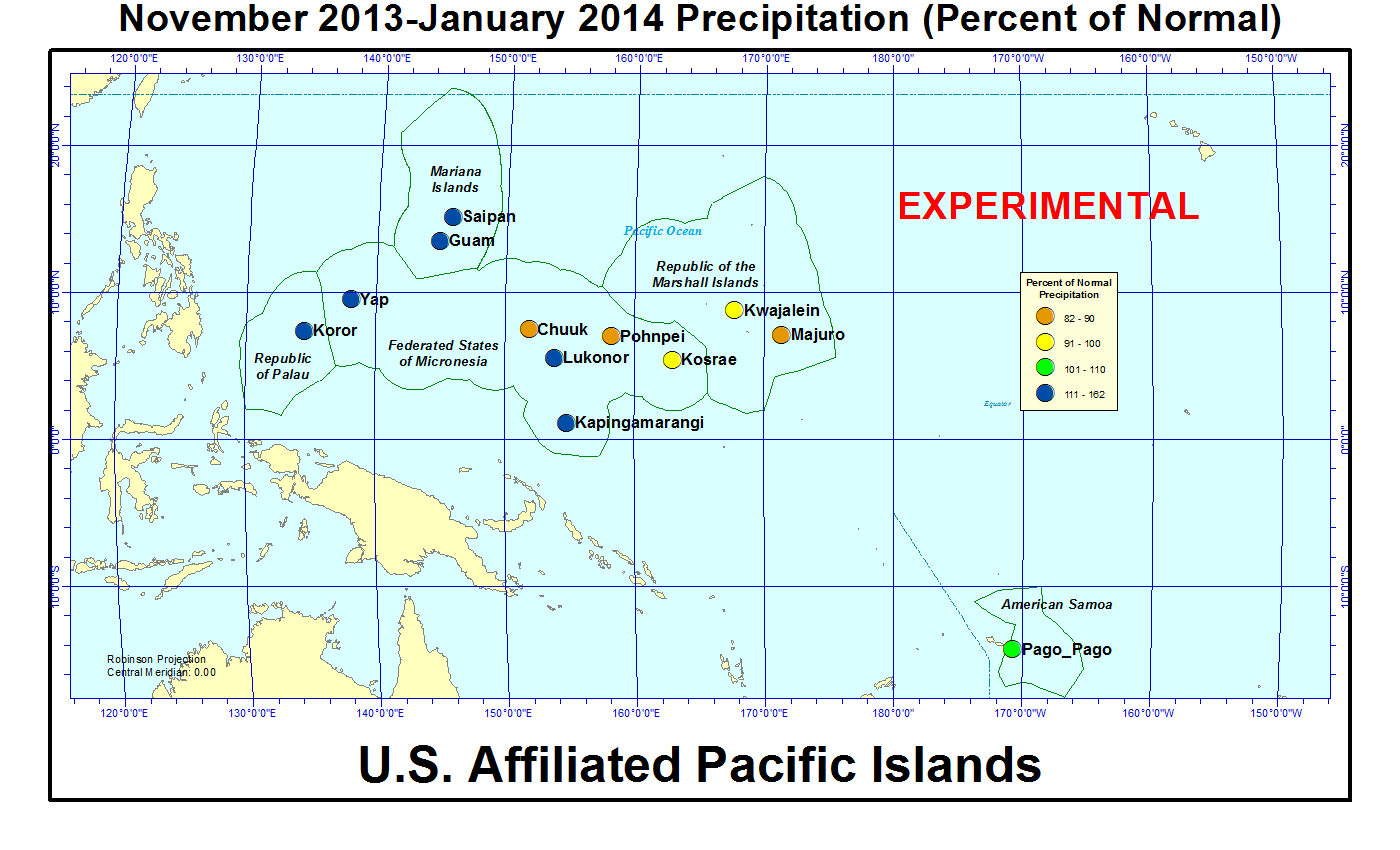
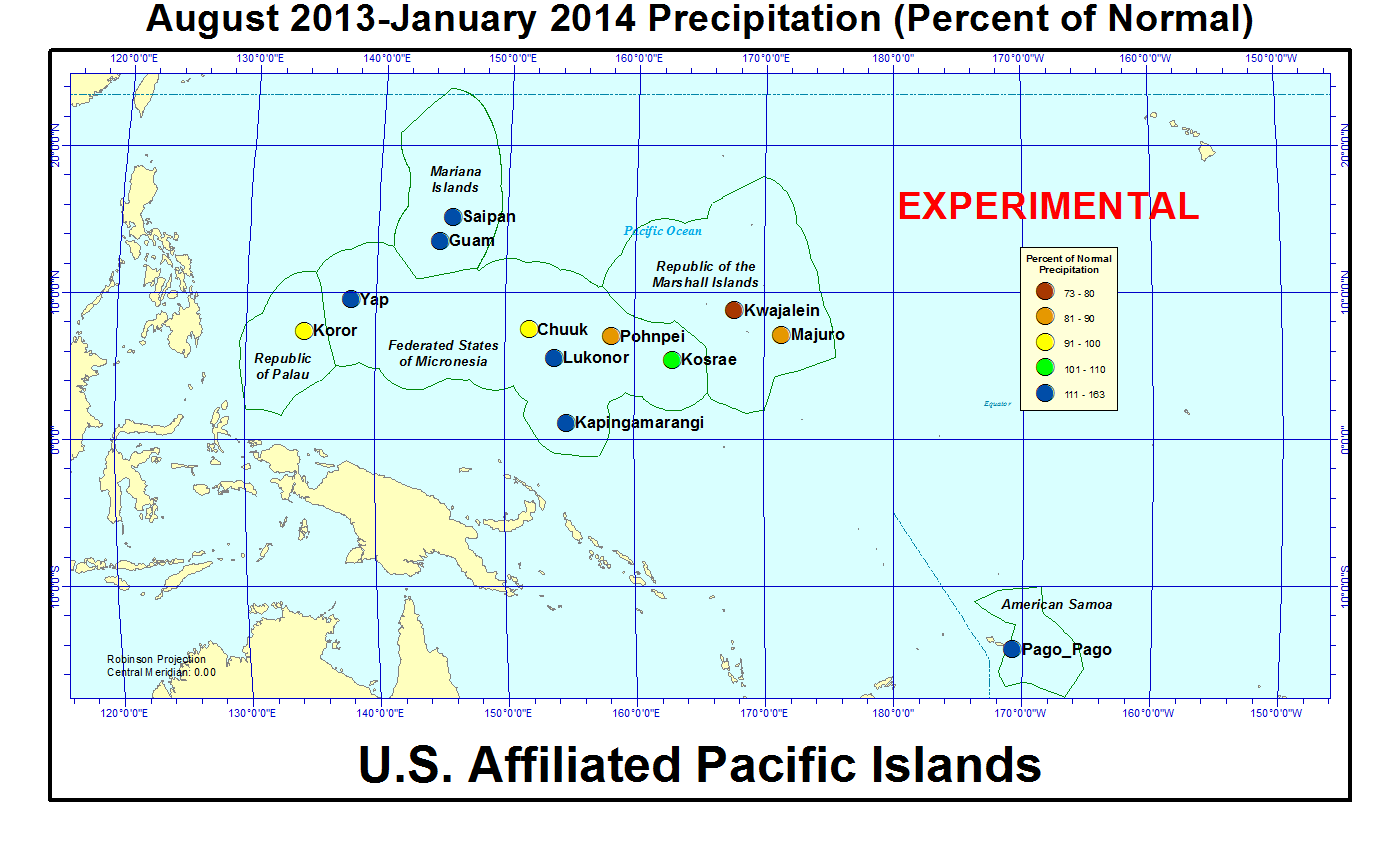

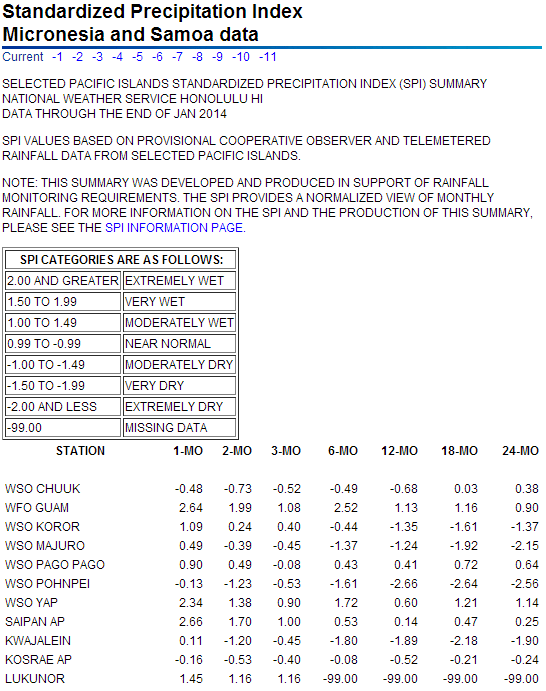
[top]
State/Regional/National Moisture Status
A detailed review of drought and moisture conditions is available for all contiguous U.S. states, the nine standard regions, and the nation (contiguous U.S.):
| northeast u. s. | east north central u. s. | central u. s. |
| southeast u. s. | west north central u. s. | south u. s. |
| southwest u. s. | northwest u. s. | west u. s. |
| Contiguous United States |
[top]
Reference Maps
Satellite-Based Drought Graphics
Agricultural and Soil Moisture Drought Graphics
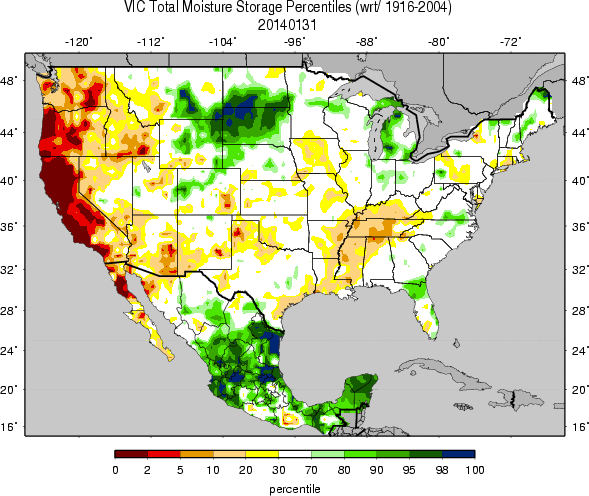
University of Washington VIC (Variable Infiltration Capacity macroscale hydrologic model) Soil Moisture Percentile
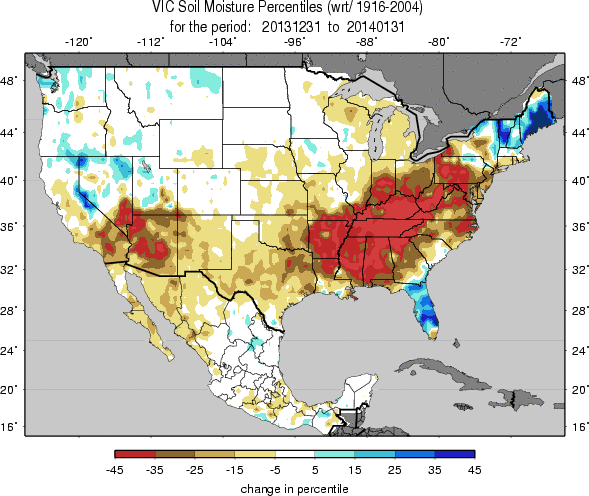
University of Washington VIC (Variable Infiltration Capacity macroscale hydrologic model) Soil Moisture Percentile 1-month Change
Hydrological Drought Graphics
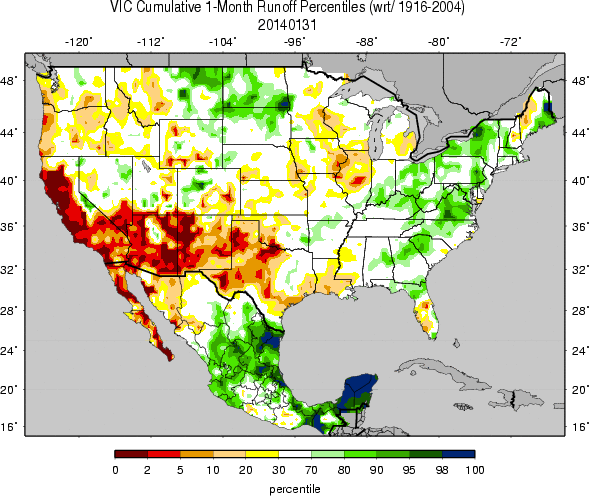
University of Washington VIC (Variable Infiltration Capacity macroscale hydrologic model) 1-Month Runoff Percentiles

University of Washington VIC (Variable Infiltration Capacity macroscale hydrologic model) 2-Month Runoff Percentiles
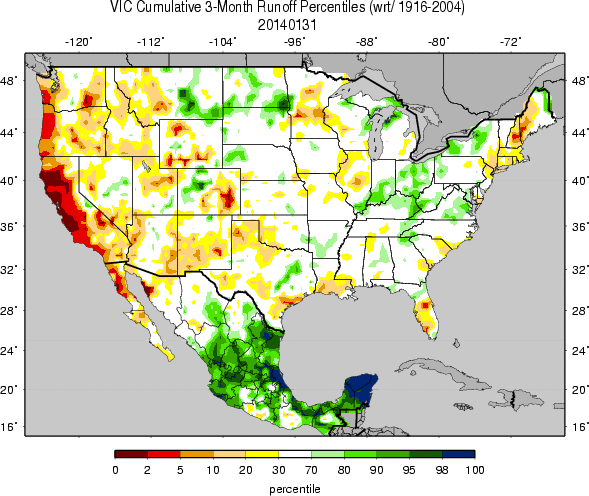
University of Washington VIC (Variable Infiltration Capacity macroscale hydrologic model) 3-Month Runoff Percentiles
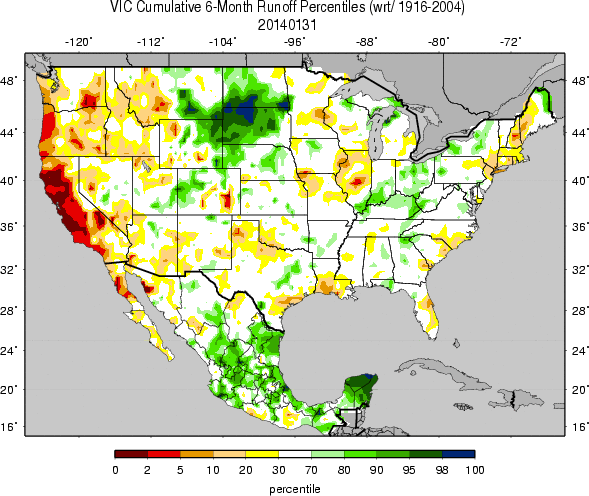
University of Washington VIC (Variable Infiltration Capacity macroscale hydrologic model) 6-Month Runoff Percentiles
Meteorological Drought Graphics - Precipitation Amount
Meteorological Drought Graphics - Precipitation Percentiles, Percent of Normal, Ranks
Meteorological Drought Graphics - Precipitation Days
Meteorological Drought Graphics - Water-Year-to-Date Precipitation Percent of Normal or Percentiles
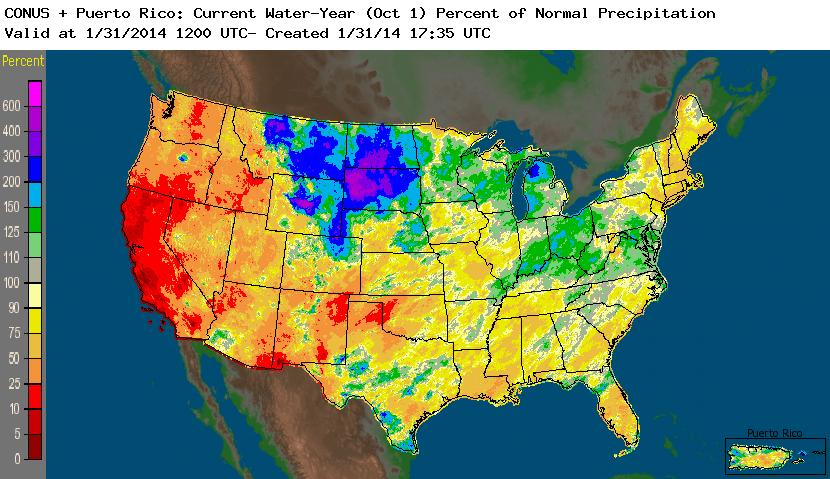
NOAA NWS (National Weather Service) Water-Year-to-Date (October 1-Present) Precipitation Percent of Normal
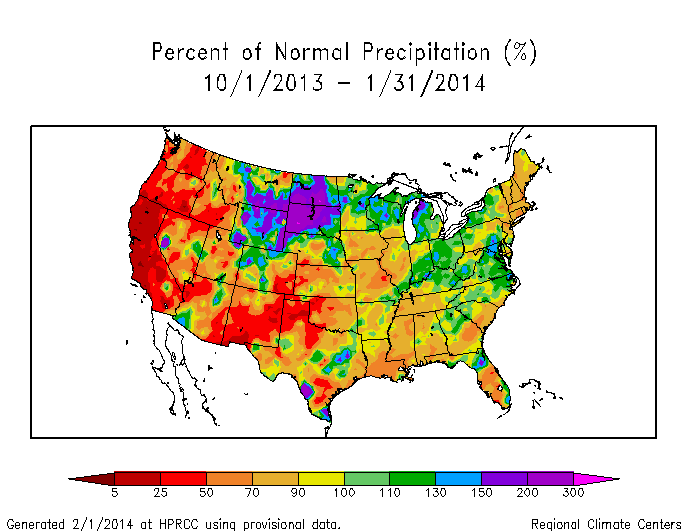
NOAA HPRCC (High Plains Regional Climate Center) Water-Year-to-Date (October 1-Present) Precipitation Percent of Normal
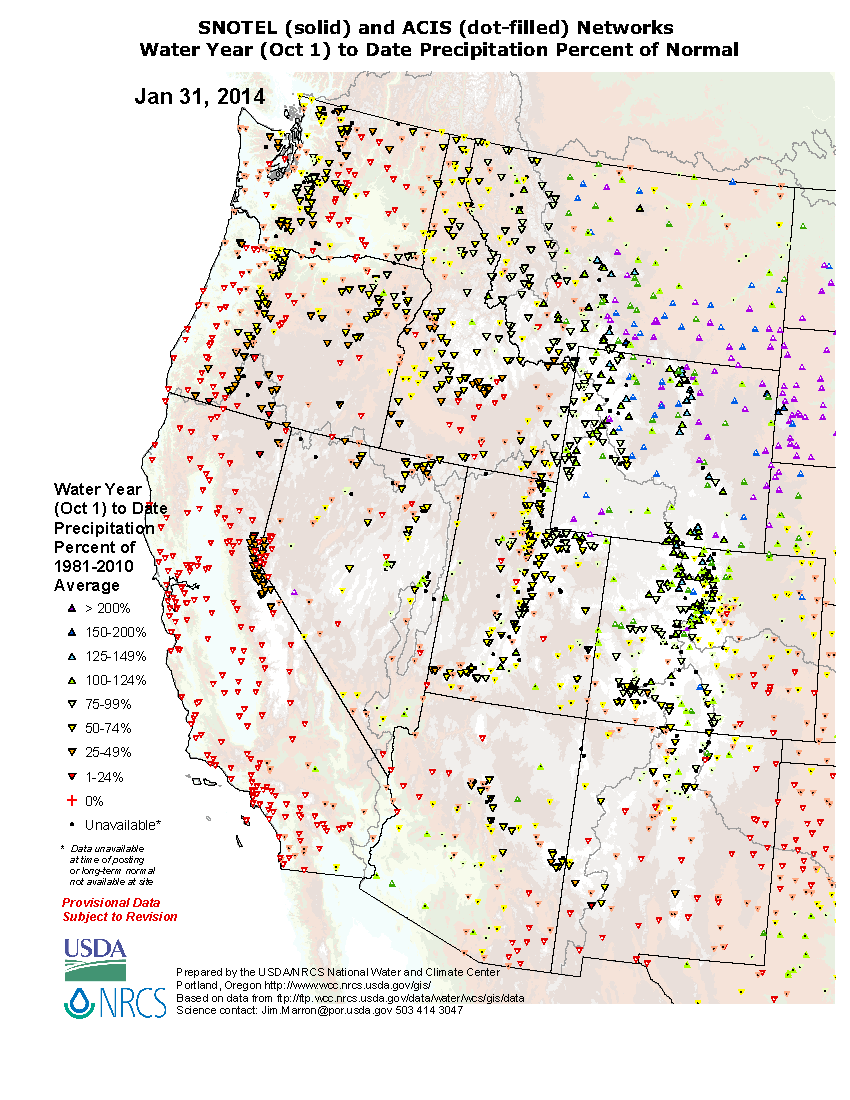
SNOTEL and ACIS Western Station Water-Year-to-Date (October 1-Present) Precipitation Percent of Normal
Meteorological Drought Graphics - Snow
Meteorological Drought Graphics - Precipitation Percent of Normal for Long Periods
Meteorological Drought Graphics - Standardized Precipitation Evapotranspiration Index (SPEI)
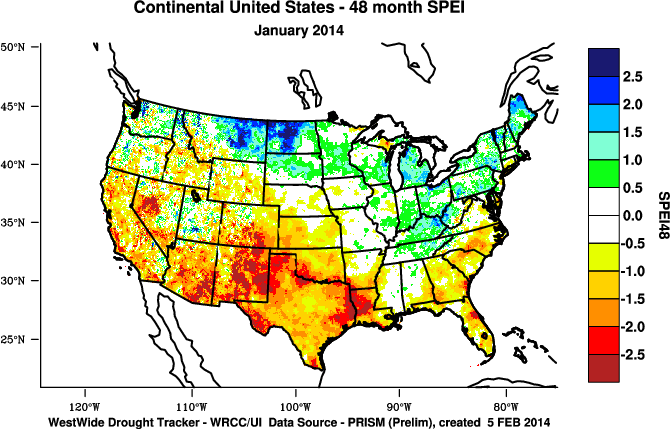
NOAA/WRCC 48-month Standardized Precipitation Evapotranspiration Index (SPEI) from Oregon State University PRISM Data (preliminary)
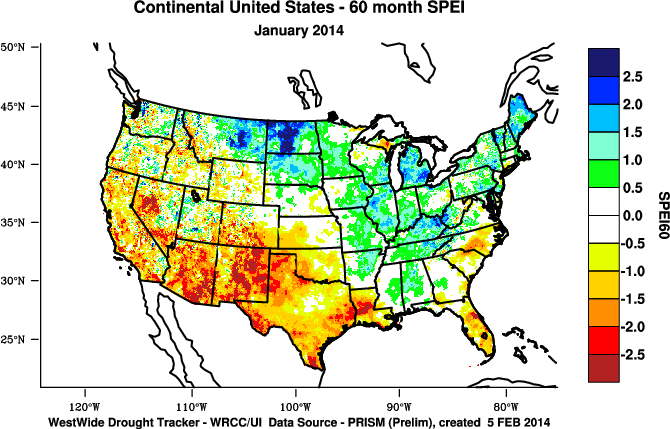
NOAA/WRCC 60-month Standardized Precipitation Evapotranspiration Index (SPEI) from Oregon State University PRISM Data (preliminary)
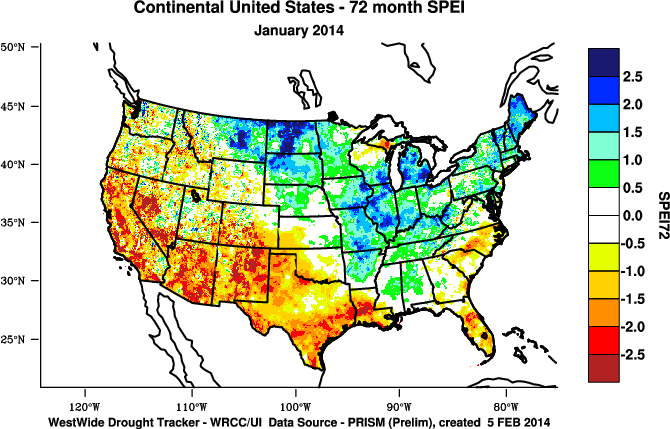
NOAA/WRCC 72-month Standardized Precipitation Evapotranspiration Index (SPEI) from Oregon State University PRISM Data (preliminary)
[top]
Contacts & Questions
 NOAA's National Centers for Environmental Information
NOAA's National Centers for Environmental Information
